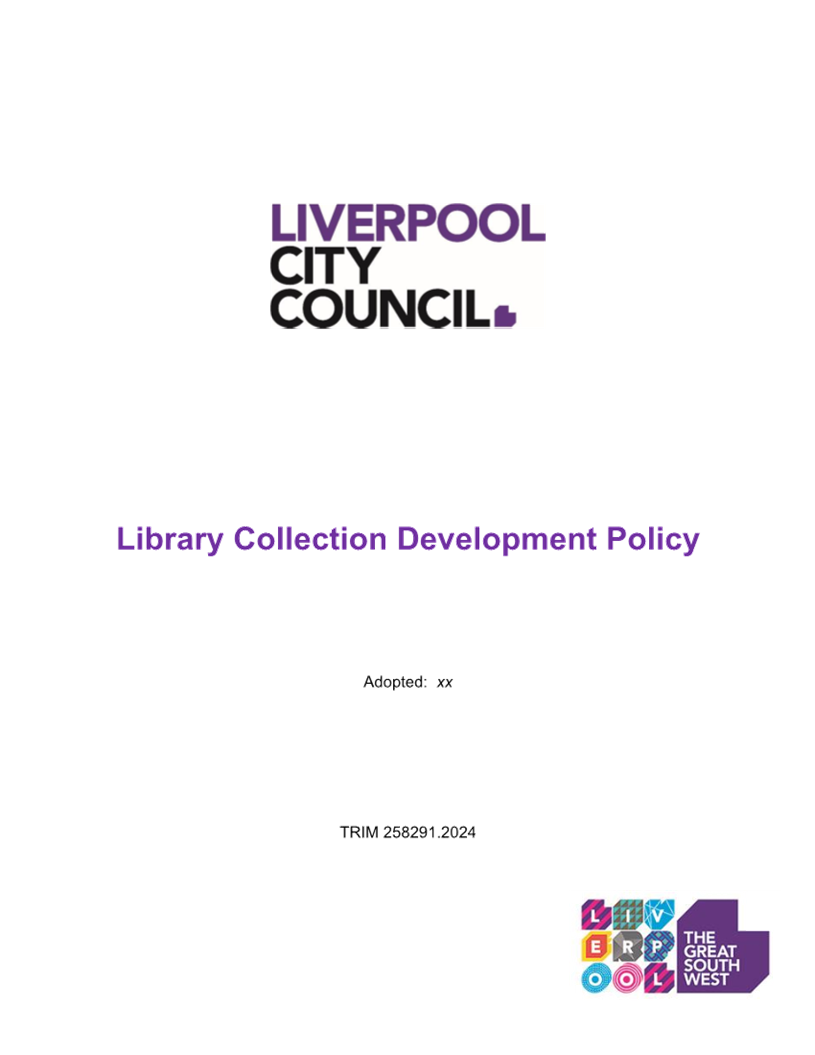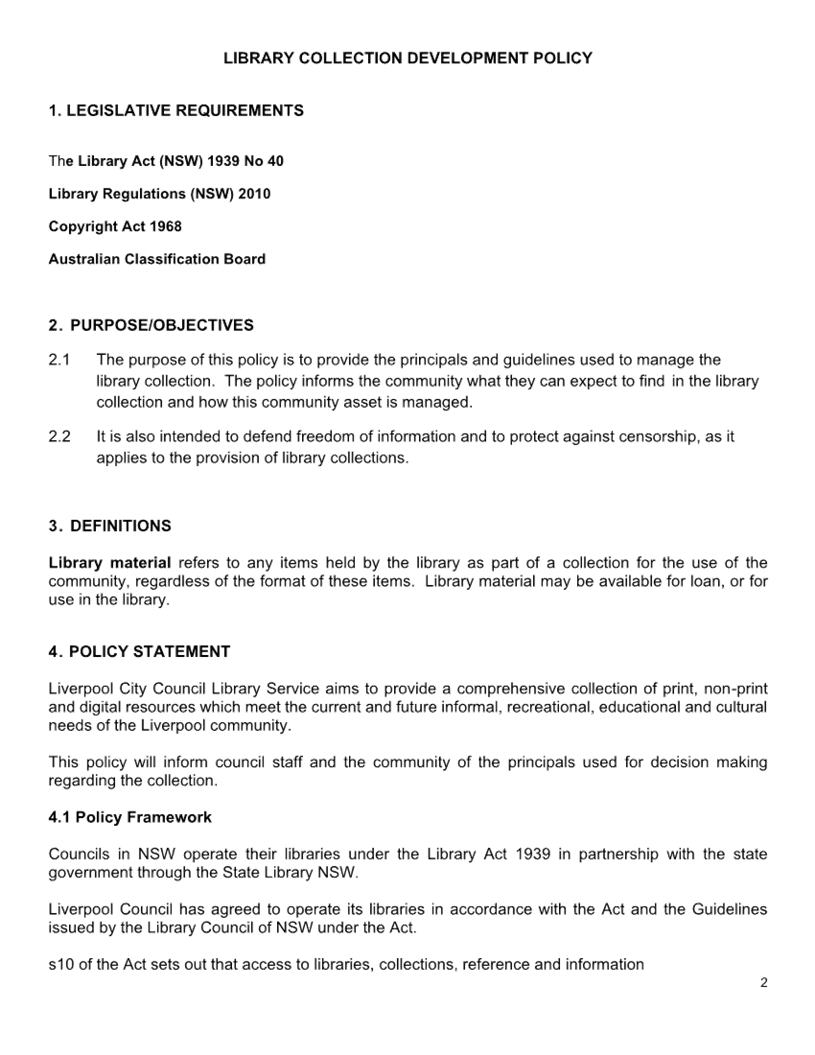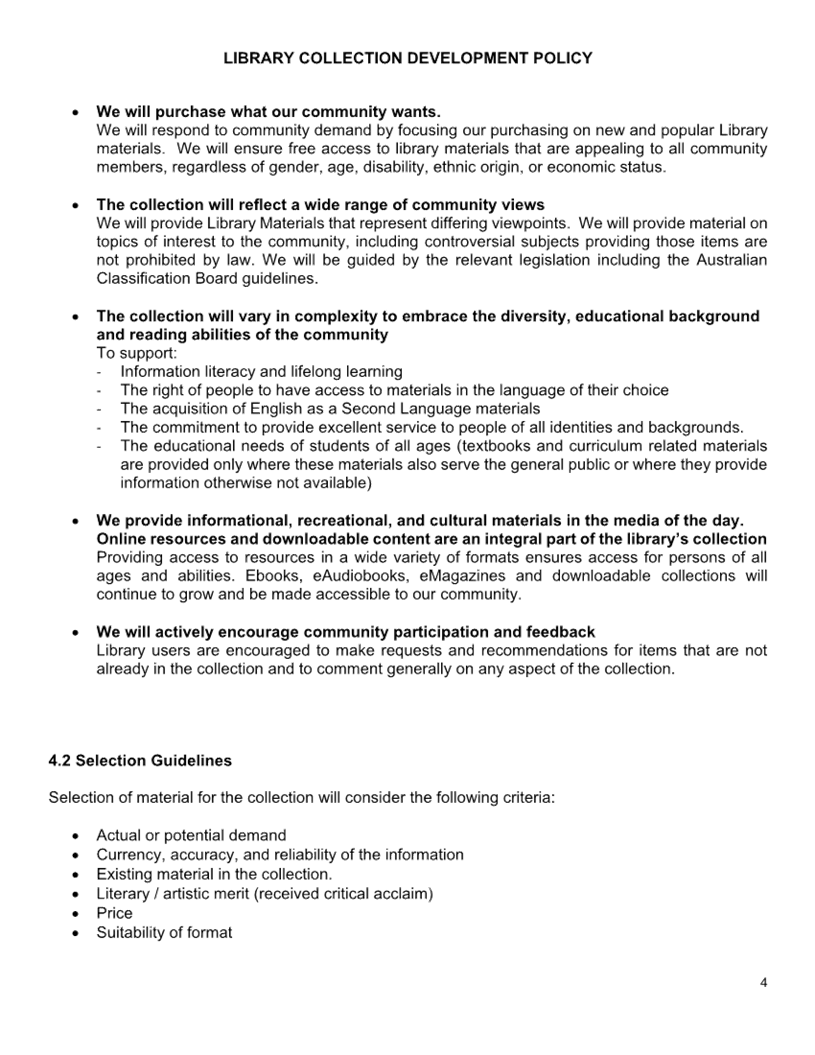AGENDA
Governance Committee Meeting
13 August 2024

You are hereby notified
that a Governance Committee Meeting of Liverpool City Council will be
held at Liverpool Civic Place, 11.08
BOARDROOM WIRRIGA (GOANNA) LEVEL 11, 50 Scott Street, Liverpool NSW 2170
on Tuesday, 13 August 2024 commencing at 1.00pm.
Please note this meeting
is closed to the public. The minutes will be submitted to the next Council
meeting.
If you have any enquiries, please contact Council and Executive Services
on 8711 7441.

Opening
Apologies
Declarations of Interest
Infrastructure and Planning
Committee
ITEM 01 Transport
Project Investment Pipeline including, Projects completed in the last 2 years,
Projects in planning, projects in design, projects in delivery, projects
approved but unfunded 4 1
ITEM 02 Voluntary
Planning Agreement Status Report - July 2024 16 2
ITEM 03 Mayoral
Minute: Liverpool Innovation Precinct 33 3
Budget Committee
NIL
Strategic Priorities Committee
ITEM 04 Amendments
to Council Venue HIre Policies 73 4
ITEM 05 Library
Collection Development Policy 78 5
Strategic Performance Committee
NIL
Presentations by Councillors
Close
Governance
Committee Meeting
13 August 2024
Infrastructure and Planning Committee Report
|
ITEM 01
|
Transport Project Investment Pipeline
including, Projects completed in the last 2 years, Projects in planning,
projects in design, projects in delivery, projects approved but unfunded
|
|
Strategic
Objective
|
Evolving,
Prosperous, Innovative
Promote and
deliver an innovative, thriving and internationally recognised city
|
|
File Ref
|
168173.2024
|
|
Report By
|
Patrick
Bastawrous - Team Leader Transport Management
Stella Qu -
Transport Planner
John Lac -
Manager Infrastructure Delivery
Scott Sidhom
- Acting Manager City Design and Public Domain
|
|
Approved
By
|
Daniel Riley
- Manager Development Engineering
|
Council
received a request from the Mayor’s Office to provide an up-to-date
source of information relating to all Road Projects being planned, designed and
constructed.
The
planning, design and construction phases of each project are managed by
separate departments across Council. As such, Staff are compiling the
relevant information into a ‘Road Project Pipeline’ master file to
provide an overview of the project pipeline.
The
purpose of this report is to provide a progress update and a current snapshot
of the road project database. The longer term intent is to develop this content
into a quarterly report to the Council Governance Committee.
That the
Governance Committee meeting:
1.
Receives and notes the Report.
2. Provides any initial
feedback
REPORT
Council has an ongoing pipeline of Road Projects that
are being planned, designed and constructed. The purpose of this report is to
track the status of these projects and provide an overview of the whole project
pipeline.
The various phases of these projects are managed by
multiple departments across Council. Staff are currently compiling the
relevant information into a ‘Road Project Pipeline’ master file
that could ultimately form the basis of quarterly reporting to the CGM.
As requested by the Mayor’s Office, the intent of
this report is to provide an update on this work and a current snapshot of the
database.
Inclusions.
The ‘Road Projects Pipeline’ is being
compiled to articulate the following information:
· List of Projects (i.e. Location and Description of works)
· Reason for the Project (i.e. MP Request, Councillor Request,
Transport for NSW (TfNSW) Request, etc.)
· Source of Funding for each phase of the project (i.e.
Capital/Operating Budget, Developer Contributions, Grant Funding, etc.)
· Estimated cost of works
· Current allocated funds
· Council Department Responsible (i.e. Traffic and Transport Planning,
Survey and Civil Engineering Design, Civil Projects Delivery, etc.)
· Status of the project (i.e. awaiting TfNSW approval, 80% concept
design, tender documents issued, etc)
Once all relevant information is populated, the
intention is to organise the ‘Road Projects Pipeline’ into a list
of projects, as follows:
· In the Queue
· Currently being planned
· Currently being designed
· Currently being constructed
· Completed (Within the last 2 years)
Attached is a Work in Progress (WIP) copy of the
‘Road Projects Pipeline’ master file.
Exclusions
It is noted that there are road projects identified in
Council’s various contribution plans that are yet to be included in this
pipeline. Work is underway to establish additional resourcing to assist in
progressing these projects into the pipeline. Once this has occurred, these
projects will be added to the ‘Road Projects Pipeline’.
In addition, there are other road projects being
delivered by others within the Liverpool Local Government Area (LGA) as
follows:
· Road projects being delivered by Private Developers (as part of
their conditions of consent). These have been excluded from the scope of this
report and will not be included in this master file. However, they are being
captured in Council’s Land Development Database.
· Road projects being delivered by the NSW Government (as part of
State-led projects) are not currently included in the master file. These will
be included as the document is further developed.
There
are no financial implications relating to this recommendation. The Road
Projects Pipeline Master File aims to improve financial transparency within
Council.
|
Economic
|
Deliver and maintain a range of transport related infrastructure such
as footpaths, bus shelters and bikeways.
Provide efficient parking for the City Centre.
Deliver a high quality local road system including provision and
maintenance of infrastructure and management of traffic issues.
|
|
Environment
|
Promote an integrated and user friendly public transport service.
Support the delivery of a range of transport options.
|
Social
|
There are no social and cultural considerations.
|
Civic
Leadership
|
Provide information about Council’s services, roles and decision
making processes.
Actively advocate for federal and state government support, funding and
services.
|
|
Legislative
|
S138 Roads Act, Australian Road Design Guidelines
(AusRoads), TfNSW Technical Manuals
|
|
Risk
|
There is no risk associated with this
report.
|
1. LCC
Road Project Pipeline - Work In Progress
2. LCC
Road Project Pipeline - Mapping
|
7
|
|
ITEM
01
|
Transport
Project Investment Pipeline including, Projects completed in the last 2
years, Projects in planning, projects in design, projects in delivery,
projects approved but unfunded
|
|
Attachment
1
|
LCC
Road Project Pipeline - Work In Progress
|








|
1
|
|
ITEM
01
|
Transport
Project Investment Pipeline including, Projects completed in the last 2
years, Projects in planning, projects in design, projects in delivery,
projects approved but unfunded
|
|
Attachment
2
|
LCC
Road Project Pipeline - Mapping
|

Governance
Committee Meeting
13 August 2024
Infrastructure and Planning Committee Report
|
ITEM 02
|
Voluntary Planning Agreement Status
Report - July 2024
|
|
Strategic
Objective
|
Visionary,
Leading, Responsible
Demonstrate
a high standard of transparency and accountability through a comprehensive
governance framework
|
|
File Ref
|
171976.2024
|
|
Report By
|
Rouzbeh
Loghmani - Coordinator Contributions Planning
|
|
Approved
By
|
Lina Kakish
- Director Planning & Compliance
|
The
purpose of this Report is to provide a quarterly summary of activity associated
with Voluntary Planning Agreements (VPAs) which are either executed or still
under negotiation.
That the Committee receives
and notes this Report.
Attachment 1 of this Report
provides a status update of Voluntary Planning Agreements (VPAs) up to 30 July
2024. The list currently includes:
· One (1) VPA Letter of Offer;
· Three (3) VPAs in draft and/or under
negotiation;
· 22 executed VPAs; and
· 10 completed VPAs.
There
are no financial implications relating to this recommendation.
|
Economic
|
There are no economic considerations associated with
this Report.
|
|
Environment
|
There are no environmental considerations associated
with this Report.
|
Social
|
There are no social and/or cultural considerations
associated with this Report.
|
Civic
Leadership
|
Provide information about Council’s services, roles and
decision-making processes.
Deliver services that are customer focused.
Operate a well-developed governance system that
demonstrates accountability, transparency and ethical conduct.
|
|
Legislative
|
Environmental Planning and Assessment Act 1979
Environmental Planning and Assessment Regulation
2021
|
|
Risk
|
There is no risk associated with this
Report.
|
1. VPA
Status Report to Council as at 30 July 2024
|
1
|
|
ITEM
02
|
Voluntary
Planning Agreement Status Report - July 2024
|
|
Attachment
1
|
VPA
Status Report to Council as at 30 July 2024
|



Governance
Committee Meeting
13 August 2024
Infrastructure and Planning Committee Report
|
ITEM 03
|
Mayoral Minute: Liverpool Innovation
Precinct
|
|
Strategic Objective
|
Liveable,
Sustainable, Resilient
Deliver
effective and efficient planning and high-quality design to provide best
outcomes for a growing city
|
|
File Ref
|
051966.2024
|
|
Report By
|
Joshua Walters - Acting
Senior Urban Designer
|
|
Approved By
|
Shayne Mallard -
Director City Futures
|
At its ordinary meeting held on 28 June 2023, Council resolved to
prepare a report to support the development of Liverpool Innovation Precinct
(LIP) that includes land use reforms and place making opportunities to be
brought back to Council.
Subsequently, City Design and Public Domain (CDPD) and Strategic
Planning teams have prepared a joint report which outlines Council’s
existing measures and recommendations that support the development of the
Liverpool Innovation Precinct, including opportunities for placemaking projects
and planning amendments.
Urban Design and Strategic Planning acknowledge the importance of
Liverpool Innovation Precinct as more than just a physical precinct within the
Liverpool City Centre, as a catalyst for economic growth and social
transformation that nurtures innovation and attracts industry leaders for the
advancement of the wider Liverpool Community.
In this regard, Urban Design are advocating several priority
projects to be fast tracked within the Liverpool Innovation Precinct, and
Strategic Planning are proposing to amend some LEP controls in relation to the
city centre as part of the LEP review process.
That the Governance Committee meeting:
1. Receives and notes this
report;
2. Investigates and
prioritises the delivery of:
a) Master Plan projects
identified to be fast-tracked within the Liverpool Innovation Precinct;
b) CBD
Signage Strategy developed as part of Council’s FY 24/25 budget;
c) CBD
Signage implementation as part of Council’s FY 25/26 budget;
d) Deliver
additional street tree plantings along Elizabeth and George Streets as part of
Council’s FY 24/25 Budget;
e) Explore
implementation of multi-function poles and banners in the Liverpool Innovation
Precinct as part of Council’s FY 24/25 budget; and
f) Advocate for key investment from the State Government which
will be a catalyst for private investment.
Background
On 28 June 2023, Council resolved the following:
“That Council:
1. Commend
Lance Chia and David Borger for the success of the Liverpool Innovation
Precinct and in particular the successful development and launch of the
Investment Prospectus.
2. Council
prepares a report to support the development of Liverpool Innovation Precinct
that includes land use reforms and place making opportunities to be brought
back to a Council Meeting in the first quarter of 2024”
The Liverpool Innovation Precinct is a unique collaboration of 10
major stakeholders in the city of Liverpool who have come together to advocate
for, and support public and private sector investment in the area.
Launched by NSW Treasurer, the Hon Daniel Mookhey MLC, on June 8,
2023, the Liverpool Innovation Precinct Investment Prospectus showcased
Liverpool’s capabilities in health, education, research, and innovation,
which aimed to attract people and investment into the precinct and the broader
city centre.
Urban Design and Strategic Planning teams have prepared this
report in response to the above resolution. This report proposes changes to the
Liverpool City Centre through various planning and placemaking opportunities to
assist in attracting more people, businesses, and investment to the Liverpool
Innovation Precinct.
This report outlines measures currently being undertaken by
Council and recommends several placemaking and planning opportunities which
will further support the growth and development of the LIP. This includes
opportunities which will help integrate the LIP within the broader city centre,
encourage more development and uplift the quality of the public spaces to
create a more desirable, liveable, and purposeful precinct that attracts more
people and investment into the area.
A map of the Liverpool Innovation Precinct can be found below.

Map 1. Boundary of the LIP
Urban Design and
Placemaking Context:
The
proposed Liverpool Innovation Precinct (LIP) forms part of the larger Liverpool
City Centre and encapsulates approximately two-thirds of the entire Liverpool
CBD. The character of LIP is as diverse as the city centre itself with a
multitude of functions, users, and stakeholder interests. This renders a
complex urban environment that has been shaped through various plans, policies,
strategies, and guidelines that inform placemaking opportunities and help guide
development outcomes within the city centre.
Council’s
CDPD team continue to undertake an urban design and placemaking led approach
towards reshaping the functionality and character of the city centre. The two
key Council documents that guide placemaking opportunities in the Liverpool CBD
are:
1.
Liverpool City Centre Public Domain Master Plan (The Master Plan)
The
Master Plan is a ten-year plan of public domain improvements (placemaking
projects) within the Liverpool City Centre, aimed at enhancing the character of
the CBD. The Master Plan aligns with Council’s Community Strategic Plan
(CSP) by establishing a realistic vision of a desirable, liveable, and functional city centre that will indirectly support the growth and development of the LIP.

The Master Plan acknowledges the potential for the
city centre to establish itself as Sydney’s third CBD, the capital of the
South West and the gateway city to the future Western Sydney (Nancy-Bird
Walton) International Airport and Aerotropolis (Bradfield). The Master Plan
proposes seven key directions for the embellishment of public space within the
Liverpool City Centre, which are:
· Improved Streets.
· Activated Serviceways / Laneways.
· Improved Gateways.
· Increased and Improved Carparking.
· New and Upgraded Open Spaces.
· Improved Rivers and Creeks.
· Enhanced Heritage Spaces.
In addition, the Master
Plan identifies opportunities for
research and innovation, and acknowledges the importance of high-quality public
spaces, infrastructure, and urban greening around establishments like housing,
offices, schools, universities, and hospitals. It identifies the importance of
connecting these places through an active and public transport network, for
creating positive change and incentivizing investment in business, health and
education that will act as catalyst for further economic growth and social
transformation.




Various Projects Proposed in the LCC
PDMP - Artist Impression
2.
Draft Liverpool City Centre Public Domain Technical Manual (The Technical
Manual)
The
Technical Manual provides detailed technical design guidance and includes
standard drawings and specifications for all public infrastructure located
within the city’s public domain (including publicly accessible but
privately-owned spaces). It will ensure that a high-quality, consistent, and
standardised palette of furniture, fixtures and finishes is implemented across
the city centre, irrespective of the funding, timing, or delivery stream
(including through private development).

The Technical Manual includes detailed design guidance
for streets and public spaces including the placement and spacing of essential
infrastructure. It also comprises detailed technical drawings and
specifications for all public domain infrastructure within the city centre,
which includes (but is not limited to):
· interfaces with commercial & industrial buildings,
residential flat buildings, schools, civic buildings, parks and services;
· core and periphery street typologies, intersections,
serviceways and laneways design etc;
· standard drawings and specifications for paving, kerb
ramps, crossings, roundabouts, traffic calming devices, kerb and gutter etc;
· standard drawings and specifications for tree
plantings, street tree pits & grates, planter boxes, WSUD, groundcovers,
shrubs, and turf etc;
· standard drawings and specifications for seats, bins,
bollards, platforms, benches, picnic benches, bike racks, drinking fountains
etc; and
· standard drawings and specifications for
multi-function poles, pedestrian lighting, bollards, parking meters, bus stops
etc.
The Technical Manual is a vital part of supporting the
growth and development of the LIP by facilitating the delivery of
Council’s vision for the city centre (outlined in the PDMP).



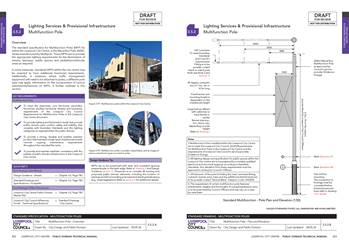
Various Extracted Pages - LCC PDTM
Project Implementation and
Funding Sources
The
Master Plan includes a comprehensive implementation plan which provides a
high-level indication of the cost implications, project priority and potential
funding sources for all identified placemaking projects. In order to support
the development of the LIP and entice further investment within the area,
considerable time and project funding is necessary. In this regard, the Master
Plan projects are proposed to be funded from various sources, including:
· Planning Proposals (PP) and Development Assessment
(DA) Applications
The Master Plan will help guide negotiations for
streetscape and public domain improvements during the Planning
Proposal/Development Application process;
· Voluntary Planning Agreements (VPAs)
The Master Plan will guide negotiations for
streetscape and public domain improvements through the Voluntary Planning
Agreement process;
· Developer Contributions (7/11) Funding
Several projects within the Master Plan can be fully
or partially funded by Developer Contributions (7/11) funding;
· Grant
Funding
The Master Plan will be, and has been used to secure
external and/or grant funding and foster collaboration with various
stakeholders for the delivery of projects;
· Collaboration Partners/Others
The Master Plan will assist in collaboration with
partners, to deliver a shared vision for the city centre; and
· Council Funding
The Master Plan will help
inform Council funded projects within the city centre, including capital works
projects and recurring maintenance works.
Master Plan Projects
(Placemaking Opportunities)
The Master Plan identifies 90
projects in the Liverpool City Centre intended to fulfill Council's vision as
Sydney’s third CBD. Curated by Council’s City Design and Public
Domain Team (in consultation with various others across Council), these
projects aim to revitalise the city centre, encourage investment, guide
high-quality development and support future growth.

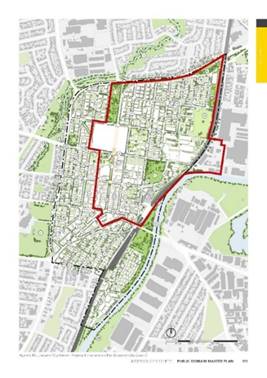
Extracted Pages 190 & 191 - LCC
PDTM
All
90 projects are categorised under the seven (7) key directions of the Master
Plan:
1. Improved Streets
The Master Plan aims to create healthier, people-oriented
streets by prioritising active and public transport. Upgrades will enhance the
amenity, safety, and comfort of our streets with new street trees, vegetation,
and high-quality infrastructure, attracting more people, businesses, and
investment.
2. Activated
Serviceways / Laneways
Serviceways and laneways are energized by directing
developments to have dual- frontages with laneway access. New infrastructure
enhances their unique character and promotes pedestrian use. Upgrades also
facilitate community events and improve pedestrian movement in the city centre.
3. Improved Gateways
Gateways are improved to define transitions, create a
sense of arrival, and aid wayfinding for motorists, cyclists, and pedestrians.
These treatments reflect the city's character and incorporate high-quality
infrastructure and points of interest.
4. Increased and
Improved Car Parking
The Master Plan enhances parking strategies by
increasing capacity and facilitating street tree planting. It encourages public
transport and aims to shift towards active and public transportation. To
alleviate city centre parking demand and congestion, accessible parking is
identified on the outskirts.
5. New and Upgraded
Open Spaces
Open space quality and quantity are increased by
retaining and enhancing existing spaces and introducing new pocket parks and
shared-use areas. Upgrades include new trees, vegetation, amenities, sports
facilities, and public infrastructure.
6. Improved Rivers and
Creeks
Improvements to the Georges River and Brickmakers
Creek include enhanced waterfront connections and embellishment of surrounding
areas with recreational infrastructure and opportunities for water interaction.
Measures are proposed to treat stormwater runoff and improve the water health.
7. Enhanced Heritage
Spaces
Indigenous, European, and Migrant and Transnational
Heritage is conserved, enhanced, and promoted in the city centre. Heritage
items including buildings, structures, parks, and monuments, are celebrated
through site-specific interventions and heritage-inspired treatments.
Master Plan Projects
within the LIP
The
Master Plan acknowledges the significance of the LIP within the city centre and
identifies a large quantity (35) of overlapping projects that will help support
its development and growth. In this regard, the overall objectives within the
broader city centre and the LIP are intertwined. A few of the key placemaking
opportunities located within the LIP include:
· Macquarie Street (North, Middle & South) Upgrade
(Improved Streets)
As the CBD’s Urban Spine and a major
anchor point for the western edge of LIP, a suite of public domain upgrades
along the length of the street is proposed, including granite paving, bluestone
kerb & gutter, organised parking, street trees, vegetation, traffic calming
and a consistent palette of furniture, fixtures and fittings.


· George Street Upgrade (Improved Streets)
Identified as a vital north-south active transport
corridor linking the Hume highway, WSU and UOW Campuses, the Liverpool Civic
Place and Liverpool Train Station to ensure active transport is at the heart of
the LIP. The vision includes a dedicated bi-directional cycleway, in road
street trees, organised parking, granite paving, bluestone kerb & gutter as
well as a consistent furniture, fixtures and fittings.
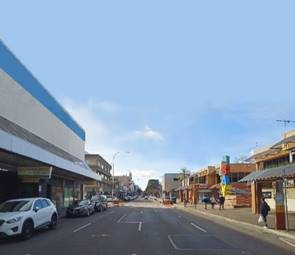

· Elizabeth Street Upgrade (Improved Streets)
Identified as a green boulevard, and a
crucial east-west link connecting Macquarie Mall, Westfield, WSU campus and the
hospital precinct to key open spaces including Bigge Park, Apex Park and St.
Lukes Anglican Church forecourt. Upgrades include footpath widening, in road
street trees, granite paving, bluestone kerb & gutter as well as a
consistent palette of furniture, fixtures and fittings that will deliver a
significant character uplift, enhanced amenity and social activation.

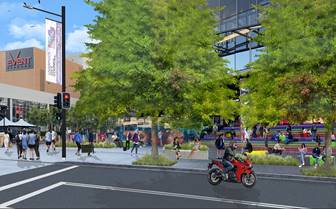
· Moore Street Upgrade (Improved Streets)
Identified as the key east-west active transport corridor connecting the Liverpool Station, Liverpool Tafe, the UOW campus
and Bigge Park to Macquarie Mall. The vision includes a dedicated
bi-directional cycleway, in road street trees, organised parking, granite
paving, bluestone kerb & gutter and a consistent palette of furniture,
fixtures and fittings that will provide active transport connectivity throughout
the LIP.
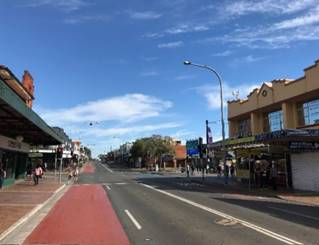
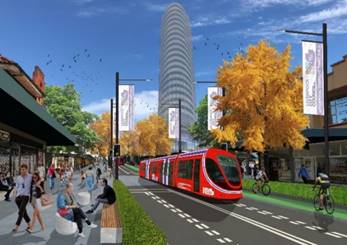
· Railway Street (Improved Streets)
A crucial link between George Street and Bigge Street, this is an
important pedestrian gateway into the city centre and LIP, when arriving from
Liverpool Station. The vision includes traffic calming measures, slower speeds,
wider footpaths, organised parking, high-quality streetscape furniture, seating
areas, gateway embellishments (including public art) street trees and
vegetation for an improved arrival experience, pedestrian safety and amenity.
· Scott
Street & Memorial Avenue Upgrade (Improved Streets)
The southern edge of the LIP and a key connection between New Bridge
Road, the Liverpool Station, Liverpool Civic Place and Woodward Place. The
proposal comprises a suite of public domain upgrades including a potential
dedicated bi-directional cycleway, granite paving, bluestone kerb & gutter,
organised parking, street trees, vegetation, traffic calming and a upgraded
furniture palette.
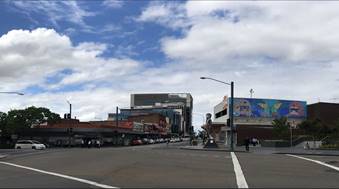
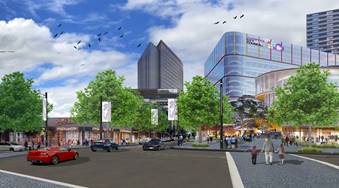
Additionally, other projects within the LIP, with the
potential to create the desired uplift to support growth, encourage development
and attract investment include:
· Liverpool Health
Precinct Streets (Improved Streets);
· Railway Serviceway
(Activated Serviceways/Laneways);
· George Lane
(Activated Serviceways/Laneways);
· Warren Serviceway
(Activated Serviceways/Laneways);
· Laurantus
Serviceway (Activated Serviceways/Laneways);
· Berryman Reserve
Gateway (Improved Gateways);
· Bigge Street North
Gateway (Improved Gateways);
· Macquarie Street
North Gateway (Improved Gateways);
· Liverpool Pioneers
Memorial Park (New and Upgrade Open Space);
· Old Liverpool
Library Forecourt (New and Upgrade Open Space);
· College Street
Pocket Park (New and Upgrade Open Space);
· Bigge Park
Embellishment (New and Upgrade Open Space);
· Georges River
Master Plan (Improved Rivers and Creeks);
· Georges River
Connection and Boardwalk (Improved Rivers and Creeks);
· Pedestrian Bridge
across Georges River (Improved Rivers and Creeks);
· Phillimona Park
(Enhanced Heritage Spaces); and
· Former Liverpool
Courthouse (Enhanced Heritage Spaces).
Council-led
Master Plan Projects Delivered within the LIP
Numerous
Master Plan projects in the LIP have been funded and delivered through multiple
funding streams including state government grants. These projects are vital for
enhancing the city’s character and changing perceptions of Liverpool to
entice further development and investment. Key completed projects within the
LIP include:
1. Railway
Serviceway (Tactical Urbanism Demonstration Project)
Funded by TfNSW’s ‘Places to
Love’ Grant Program, this project was completed in early 2022 in Railway
Serviceway. Despite a small budget, the project used low-cost, high-impact
design strategies to add seating, umbrellas, plants, trees, road paint, traffic
calming, and public art. This initiative successfully revitalised an
underutilised public area, testing long-term solutions through short-term
low-cost trials.

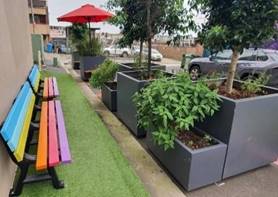
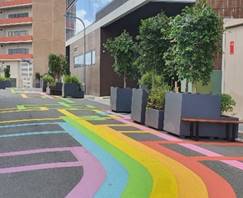
2. Railway Street
(Shared Spaces Demonstration Project)
Funded
by TfNSW’s ‘Streets for Shared Spaces Round 2’ Grant Program,
this project was successfully completed in mid-2023, in Railway Street. The
project was designed to activate the street, stimulate local economy, and
enhance the streetscape within a relatively small budget and timeframe. The
intention of this project was to test high impact streetscape changes, used to
inform a permanent reconfiguration as part of the successful West Invest Grant
Program.
The project delivered a temporary footpath widening, kerb buildouts with
parklets, barriers, surface treatments, street lines and artificial
turf. An outdoor dining area was included with temporary furniture,
barriers, shading devices, and lighting. The creation of recreation areas
with temporary seating, furniture, planter boxes, and barriers were implemented
and a community event held with pop-up activities.
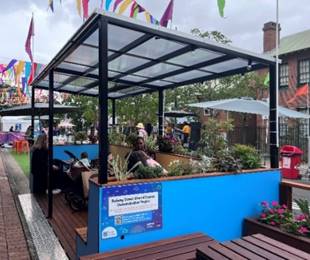
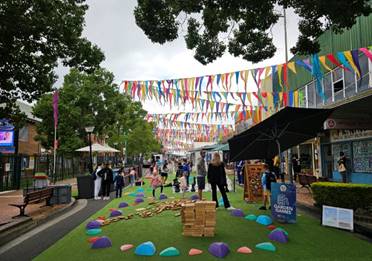
3. Former
Liverpool Courthouse (Restoration Project)
Restoration
works to activate the former Liverpool Courthouse building and surrounding
gardens are presently being undertaken by Council. Funded by various sources (including grants and Council’s
capital works), the project intends to
capitalise on opportunities to reengage the community with Liverpool's history
by reinvigorating the courthouse building and surrounding public space. The
proposed works include restoring the building façade, front stone wall,
fence, and gate as well as a enhancing the courtyard to the rear, removing the
intrusive green fence and the provisioning of a period sensitive landscaping
along the Moore Street frontage.
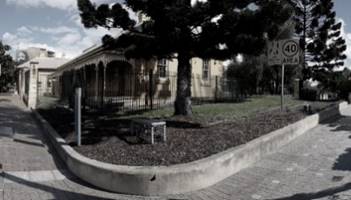
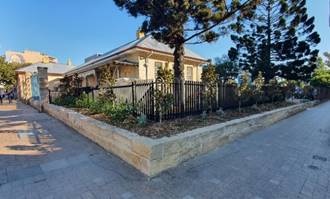
4. Bigge Park Embellishment
(New and Upgrade Open Space)
Embellishment works at Bigge Park have been delivered
in multiple phases over several years and funded through various streams and
programs. Bigge Park is a pivotal space at the heart of the LIP and an
important part of the city’s ongoing revitalisation. A central community
hub providing high-quality amenity, passive open space, abundant lawns, trees,
water play, showers, changerooms, exercise equipment and play facilities within
proximity to many health, education, research, and commercial developments.
Council’s Master Plan has informed upgrade works including new public art
and lighting (grant funded) and the planting of over 65 new trees (grant
funded), as well as new street paving and vegetation as part of ongoing capital
works and maintenance programs. Council is also investigating a comprehensive
Public Art Program for Bigge Park through another Council resolution which
would provide additional uplift to this significant open space.
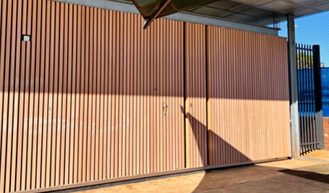
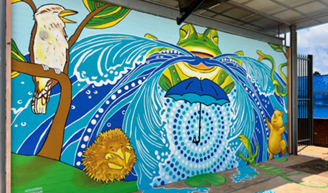
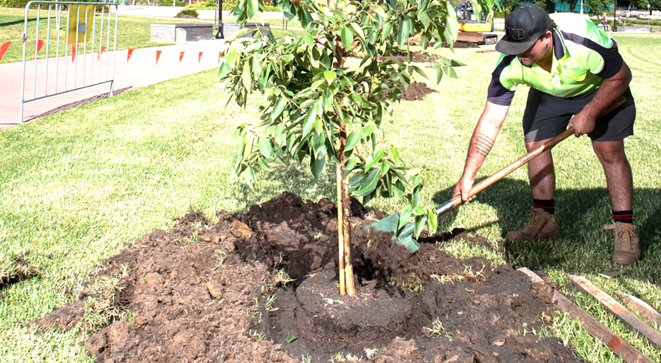
5. Urban Forest Strategy
& Tree Management Framework
Planting more trees in the city centre is essential
for reducing urban temperatures and enhancing our public spaces to create a
more liveable city and encourage people and investment. Council secured $1.75
million in co-funded grants from the Five Million Trees for Greater Sydney,
Greening our City, and Greener Neighbourhoods programs for new tree plantings
and other tree related projects. The Urban Forest Strategy and Tree Management
Framework (including an updated Tree Policy, new Tree Management Strategy, and
Guidelines) aim to increase tree canopy cover in the CBD, making it more
comfortable and liveable within the heart of the LIP.
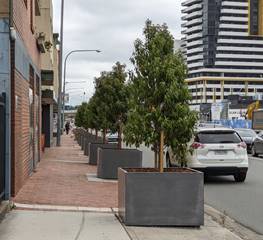


Council-led
Master Plan Projects in the LIP with Funding
Several
Master Plan projects within the LIP have been awarded / allocated funding for
implementation. A number of these projects are currently within the initial
design and investigation phases. The projects received funding through various
streams including the NSW State Government grant programs (e.g., WestInvest,
Public Space Legacy Program and Get Active NSW) and Council’s ongoing
capital works and maintenance programs. Overall, Council was successfully
awarded more than $100 million in state government grant funding for the design
and/or delivery of these major city shaping infrastructure projects. All
successful grants were informed by the Master Plan, with the forthcoming
detailed design
and construction works to be guided by the Technical
Manual.
These projects are important first steps for Liverpool’s revitalisation,
to encourage investment and support development within the LIP and surrounding
city centre. Some of the key funded Master Plan projects located within the
Liverpool Innovation Precinct include:
1. Macquarie
Street (Middle) Streetscape Upgrade
Macquarie
Street, Liverpool's "High Street", is the central hub of the city and
its Innovation Precinct. Recognised in the Master Plan as a cultural and social
activity centre, the Macquarie Street (Middle) project received funding in 2020
from the NSW Government's Public Space Legacy Program. Guided by the Master
Plan and Draft Technical Manual, the project is in final design stages, with
work expected to start in mid-2024. The works include major infrastructure
upgrades such as high-quality public domain infrastructure (furniture,
fixtures, and fittings), paving, street trees, vegetation, lighting, and
opportunities for outdoor dining. This revitalisation supports growth and
enhances the city's overall character at the heart of the LIP.
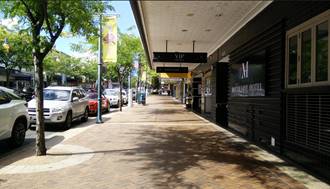
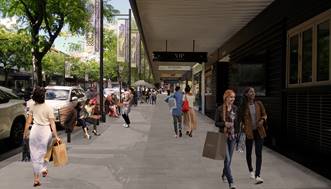
2. Macquarie Street (South & North)
Upgrade
The Master Plan highlights Macquarie Street as a key
cultural and social hub. Macquarie Street (North) will be a significant
attraction for the LIP, connecting Pioneers Memorial Park, Westfields, and
Macquarie Mall. In 2023, the Macquarie Street (North & South) project
received funding from the NSW Government's Western Sydney Infrastructure Grants
Program (WestInvest). Guided by the Master Plan and Draft Technical Manual, the
project is in early design stages, with construction work expected to start in
late 2024. The works include major infrastructure upgrades such as high-quality
public domain infrastructure (furniture, fixtures, and fittings), paving,
street trees, vegetation, lighting, and opportunities for
outdoor
dining.
3. Railway
Street Upgrade
The
Railway Street project will embellish an important pedestrian connection
between George Street and Bigge Street and define a key pedestrian gateway for
the Innovation Precinct. In 2023, the project was awarded funding as part of
the NSW Governments Western Sydney Infrastructure Grants Program (WestInvest).
The proposed works are currently in the early design and investigation phases,
and will include traffic calming measures, slower speeds, wider footpaths,
organised parking, high-quality streetscape furniture, seating areas, outdoor
dining provisions, gateway embellishments (including public art), trees and
vegetation for an overall improved arrival
experience, pedestrian movement, safety, and amenity.

4. Scott Street &
Memorial Avenue Upgrade
The southern edge of the LIP and a key connection
between New Bridge Road, the Liverpool Station and Liverpool Civic Place, the
Scott Street & Memorial Avenue upgrade project will be a significant step
forward for this rapidly advancing precinct. In 2023, the Scott Street &
Memorial Avenue project was awarded funding as part of the NSW Governments
Western Sydney Infrastructure Grants Program (WestInvest). The proposed works
are currently in the early design and investigation phases and will contain a
suite of public domain upgrades including granite paving, bluestone kerb &
gutter, organised parking, street trees, vegetation, traffic calming and a
consistent
furniture palette as a potential bi-directional cycleway.

In
addition, some other significant (currently funded) Master Plan projects
located within the LIP, include:
5. George Street Cycleway (Get Active NSW Grant);
6. Moore
Street Cycleway (Get Active NSW Grant);
7. Phillimona
Gardens Project (Public Space Legacy Program);
8. Liverpool
Pioneers Memorial Park (Council Funded); and
9. Georges River Master Plan (Council Funded).
Master Plan &
Technical Manual Guiding Development in the LIP
The
Master Plan & Technical Manual are important instruments for Council in
guiding the growth and development of the LIP. They help set new benchmarks for
the quality of the public domain and work towards changing expectations for the
standard of development, this includes the guiding of projects that are funded
and delivered through private development.
The Master Plan sets the vision for all new development to follow, providing a
consistent and cohesive adopted strategy for all streetscape works. The Technical
Manual ensures this strategy will be delivered by providing detailed guidance
for the placement, specification, and implementation of all public domain
infrastructure, whilst both documents guide new development to work cohesively
across the public and private realm (i.e., interfaces).
A major part of the embellishment and uplift of the LIP is achieved through
private development works within the public domain. These works are typically
facilitated through conditions of consent and generally involve significant
streetscape upgrade works. When completed to the expected standard, these new
streetscapes will facilitate a more liveable, desirable city and attract
further investment in the precinct. Some examples of completed projects that
were successfully guided by the Master Plan and Technical Manual documents,
include:
1. Liverpool Health
Precinct (Street Upgrades)
These streetscape upgrades works are currently being
funded and delivered as part of the broader Liverpool Health and Academic
Precinct redevelopment. Council's Master Plan and Technical Manual documents
have been instrumental in guiding the design and delivery of public domain
infrastructure ensuring the proposal is consistent with the broader Liverpool
City Centre and Innovation Precinct vision.
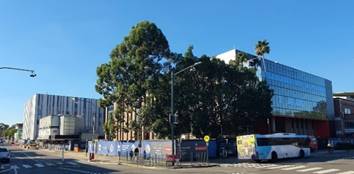
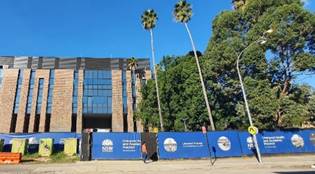
2. Scott & Terminus Street Upgrade
(Civic Place)
Partial streetscape upgrade works to both Scott & Terminus Streets
have been facilitated through the Civic Place development. These works demonstrate
the high-quality furniture, fixtures and fittings that the Master Plan
envisioned. The Technical Manual guided the delivery of a consistent, robust,
and aesthetically pleasing palette of public domain infrastructure that
supports the integration of this significant
development
within the broader city centre.
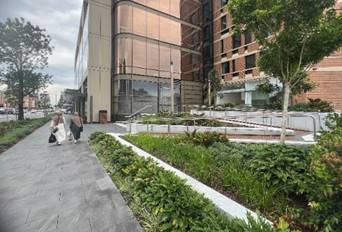
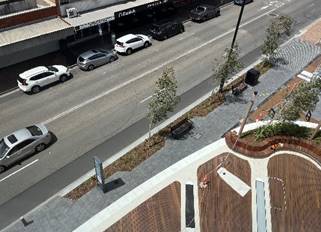
3. 167 Northumberland Street, Street Upgrade
Upgrade works to a portion of the streetscape have
been enabled through the development of 167 Northumberland Street. These works
showcase the high-quality paving, bins, seats, street lighting, tree
pits/grates, street trees and bike racks from the Technical Manual, which
provides an immediate impact on the quality of the public domain and strengthens
the integration of the building within the city centre.
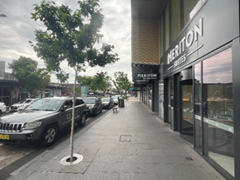
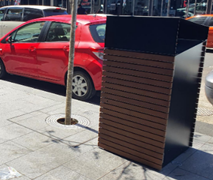
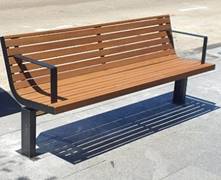
4.
Laurantus Serviceway Upgrade (167 Northumberland Street)
A section of the serviceway has been upgraded as part
of the redevelopment of 167 Northumberland Street. These works demonstrate a
potential shift Liverpool’s character through the implementation of the
high-quality serviceway/laneway paving envisioned in the Master Plan. The
document was used in the initial stages of the development application to
inform the desired outcome for the serviceway, with the Technical Manual
providing the relevant paving specifications, technical guidance, and
construction information during the detailed design phases of the application
to
ensure the
works were consistent with Councils requirements.
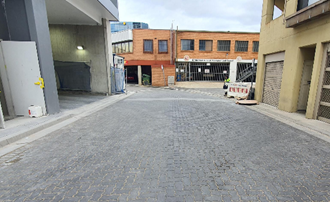
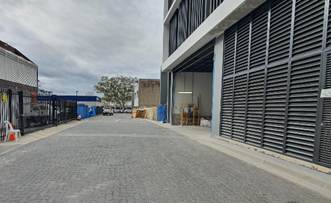
5. 4-6 Bigge Street,
Warwick Farm
Streetscape upgrade works at 4-6 Bigge Street, were facilitated through
the construction of a residential flat building. These works showcase
differences in the envisioned character between the Core and Periphery areas of
the city centre, reflected through the materials and furniture palette. Located
within the periphery area of the city centre, guided by the Technical Manual,
the development included the delivery of new kerb and gutter, large street
trees, tree pits and grates as well as an interconnected Stratavault
structural soil trench which provides abundant soil volume to facilitate the
healthy growth and development of street trees within the footpath, crucial for
safer, greener, cooler, and higher amenity streets within the LIP.
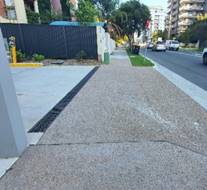
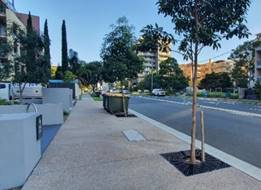

6. New Liverpool Primary
School
Streetscape upgrades at 18 Forbes Street were
delivered as part of the New Liverpool Public School development. The included
public domain works were funded by the NSW Department of Education as part of
the wider development. The works showcase the public domain palette for the
periphery areas including new coloured concrete paving, a shared path, kerb and
gutter, raised driveway crossing (pedestrian / cyclist priority), paved
medians, large street trees, garden beds, bollards, bins and seats in accordance
with the Technical Manual.
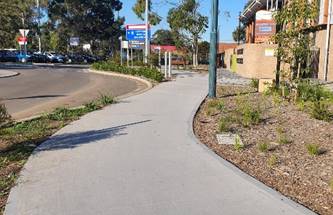
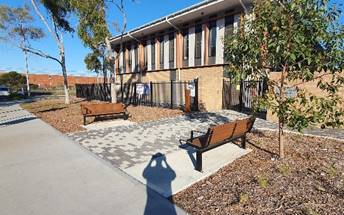
Master
Plan Projects in the LIP to be Fast-tracked
As
stated above, The Master Plan identifies 90 projects across the city centre,
with about 35 overlapping with the LIP. Due to varying funding, timelines, and
demand, several significant and potentially high-impact projects remain
unfunded and/or uninitiated. These projects are crucial for creating a vibrant,
accessible, comfortable, and safe environment within the CBD to support further
growth and development, and attract people and investment to the LIP. The
projects recommended by the CDPD Team, to be fast-tracked include:
1. Elizabeth Street
Upgrade
Identified
as a ‘Green boulevard’, and a key east-west link connecting
Macquarie Mall, Westfield, the WSU campus, and the Liverpool Health and
Academic Precinct to key open spaces within the city centre including Bigge
Park, Apex Park and St. Lukes Anglican Church forecourt. Prioritisation of this
streetscape upgrade would generate impactful change to the character of
Liverpool’s public spaces. Several sites along Elizabeth Street are
currently earmarked for private redevelopment and will incorporate significant
upgrades to the public domain including increased setbacks, wider footpaths
(along the southern side), granite paving, bluestone kerb and gutter as well as
a consistent / high-quality suite of furniture, fixtures, and fittings.


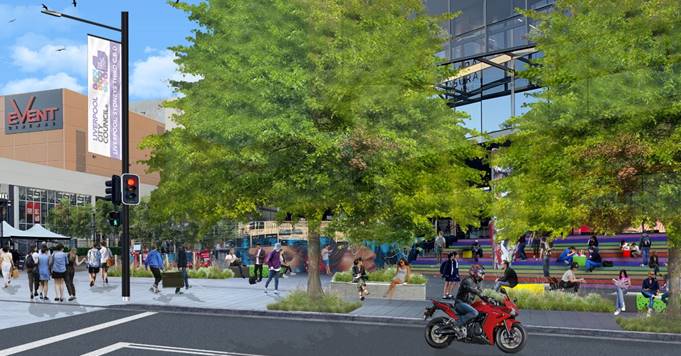
2. George Street Upgrade
Identified as the city centre’s key north-south
active transport corridor connecting Hume highway, the WSU Campus, the new
Civic Place and Liverpool Train Station. This project includes a dedicated
on-street bi-directional cycleway, kerb buildouts, in road tree pits and street
trees, organised parking, granite paving, bluestone kerb and gutter as well as
a consistent palette of furniture, fixtures and fittings that will ensure
active transport, movement and connectivity is at the heart of the LIP.
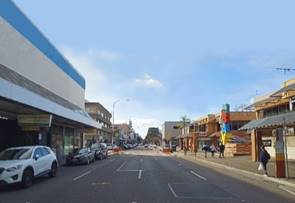
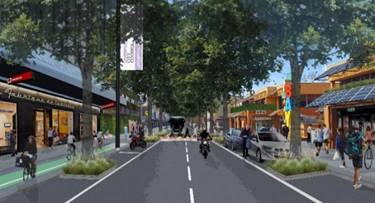
3. Moore Street Upgrade
Identified as the city centre’s key east-west
active transport corridor connecting the
Liverpool Station, Liverpool Tafe, the UOW campus and Bigge Park to Macquarie
mall and the city core. This project includes a dedicated bi-directional
cycleway, kerb buildouts, in road street trees, organised parking, granite
paving, bluestone kerb and gutter as well as a consistent palette of furniture,
fixtures and fittings that will ensure active transport, movement and
connectivity is integrated into LIP.
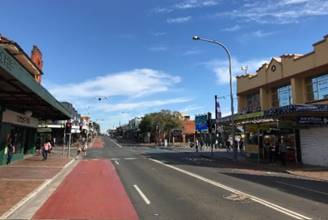
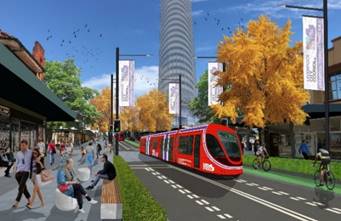
In addition, some other Master Plan projects located
within the LIP that are recommended to be fast-tracked, include:
4. Bigge Street Upgrade;
5. Campbell Street Upgrade;
6. Berryman Reserve Gateway;
7. Bigge Street North Gateway; and
8. Pedestrian Bridge across Georges River.
Liverpool City Centre and
Innovation Precinct as a University City
The
presence of three leading universities WSU, UOW and UNSW within the LIP sets
the foundations as a hub for research and innovation. Council’s
aspirations for the CBD to become a true University City can be achieved by
building upon the existing foundations and providing an impetus to support the
needs of various user groups, stakeholders and businesses creating momentum for significant economic
and social growth.
Embellishment
of our streetscapes, open spaces, laneways, plazas and new high-quality
development, guided by the Master Plan and Technical Manual will help create
meaningful change and shift perceptions of Liverpool as a healthier and more
liveable city that caters to a wider demographic (including young adults) and
supporting new development and investment in the health, research and academic
sectors.
With
excellent transport connections and abundant greenery, surrounded by engaging
architecture, quality public spaces and canopy trees, the envisioned city
centre promises a vibrant hub for living, learning, working, and leisure. In
this regard, Liverpool can cater to the innovative and research-based needs of
the health and education sectors through the guidance of the Master Plan and
Technical Manual and become a true University City. In this regard, the Master
Plan identifies several projects within the LIP (which are yet to be funded)
that are targeted at youth and university age students, including:
1. College
Street Pocket Park
Identified as a youth space, this small pocket of land
on the corner of Moore Street and College Street (nestled between TAFE and
Liverpool Bus Station) has potential to provide a multi-purpose recreation
space focused around the needs of the younger population and students. This
space would provide the opportunity to socialise, gather and recreate,
fostering a sense of belonging within the community.
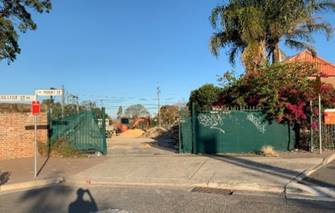

2. Old Liverpool Library
Forecourt (New and Upgrade Open Space)
The forecourt of Former Liverpool Library has been a
popular location for youth within the city centre for several years. Council
has hosted many temporary activation events here for the City’s youth.
There are ample opportunities here to create a meaningful space adjacent to the
UOW campus and in proximity to several key locations within the LIP, which are
all captured in the Master Plan.

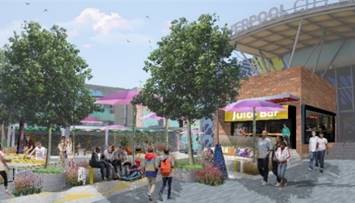
3. Liverpool Tafe Forecourt (New and Upgrade Open Space)
Bordered
by the TAFE building, Bigge Street and Moore Street, the space is crucially
located opposite Bigge Park and positioned adjacent to highly utilised
footpaths, popular for pedestrians walking to and from Liverpool Station. This
space has the potential to uplift the area and encourage further embellishment
/ development whilst providing a passive public space focused around the needs
of students and workers.
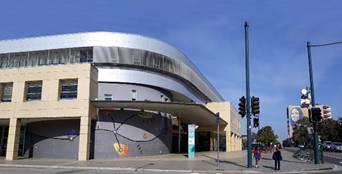

4. Western Sydney University Forecourt (New and Upgrade
Open Space)
An empty
forecourt located outside of the WSU campus, which adjoins the Westfield
Shopping Centre. This public area has the potential to provide greater
functionality for WSU students to utilise before & after classes. Given the
site’s proximity to Macquarie Mall and the Westfield Shopping Centre
entrance, this area also provides the opportunity to uplift the character of
this key pedestrian street offering prospects to foster greater social
interaction for the community within our streets.
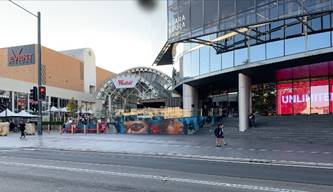

With more university age people within the city
centre, the demand industries like dining, bars and night clubs will increase
with the potential for Liverpool to develop an 18hr economy in the future,
opening up opportunities for further investment into these supporting
industries within the Innovation Precinct and further stimulating the local
economy.
Active and Public
Transport within the Liverpool Innovation Precinct
As
part of Transport for NSW’s ‘2023/24 Get NSW Active’ grant
program, Council was successful in its application to facilitate the design of
dedicated cycleways along two key arterial streets within the Liverpool City
Centre. George Street and Moore Street were identified by the Master Plan as
the city’s key active and public transport links, in which the concept
plans and imagery were used as part of the successful grant application.
Providing dedicated active transport links along the city centre’s key east-west
and north-south streets within the LIP will revolutionise transportation within
the CBD and provide opportunities to attract a younger demographic more
associated with active and healthy lifestyles. This project will also enable
the community to choose a more sustainable mode of transport and reduce overall
traffic congestion within the CBD including a lessening any potential conflict
with cars and pedestrians, making it safer and more comfortable for people to
ride, walk and drive on our streets within the LIP.
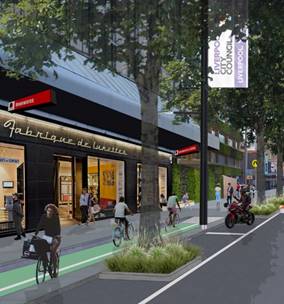
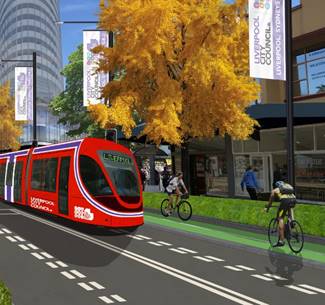

Public Art within the
Liverpool Innovation Precinct
Public
Art is an integral part of city cultural expression that captures various
facets of society and its community. It adds meaning to the city and reflects
its uniqueness by providing a canvas for expression through various art forms
and art types. A public art survey conducted in 2019 indicates that Liverpool
community believes Public Art is an important aspect of their readings of the
city. 98.1% of respondents identified Public Art as a positive addition to
facilities and public spaces, 97.4% cited that they believed the council should
invest in and/or identify opportunities to increase Public Art across the LGA,
and 97.7% of respondents agreed Public Art should be included in new
developments.
Apart from providing a myriad of cultural, social, and
economic benefits, public art instils a sense of community pride and ownership.
It results in generating interests across boundaries and adds value to the
overall character of the area. The diverse expressions and narratives within
public art can entice different age groups including university students and
workers / visitors within the precinct. Adequate consideration for public art
as part of future developments within the LIP will help achieve far greater
benefits in attracting investments and interests from various stakeholders,
agencies, and developer groups.
The CDPD Team is currently working on a Public Art
Strategy that will identify key directions and actions to deliver a broad array
of public art programs, projects, and opportunities while supporting the local
arts community through collaboration / capacity building. A recent example of
public art delivered in Regal Lane and Railway Serviceway is captured below.

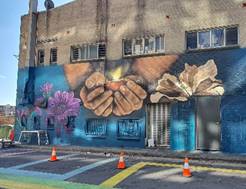
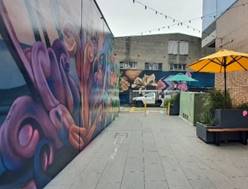
Heritage within the
Liverpool Innovation Precinct
With
a rich First Nations history and one of the oldest settlements in New South
Wales and the first free settlement, the origins of Liverpool as a town is
anchored in our colonial past however over the succeeding decades, our heritage
has evolved, and our community’s recognition of heritage has changed. It
is important that the various layer of history are preserved as part of any
future works across the precinct. The current Liverpool Heritage Strategy sets
out the plan to protect, conserve and enhance our city’s heritage
buildings, places, objects and culture. It plan has been developed with the
assistance of the community to ensure the city’s rich combination of
traditions, memories, places and objects are identified and protected.
Other
Activision, Event, Placemaking and Marketing Opportunities
In
addition to the potential future activations at Moore Point, there are also
plans to further enhance activations at Bigge Park. The success of the recent
Australia Day BBQ and related entertainment, which attracted 1500 attendees, underscores the
park's potential as a community hub for the city centre and LIP. Future
proposed activations at Bigge Park include light shows and family-focused film
nights, aimed at fostering a vibrant community atmosphere.
As
mentioned earlier in the report, recent improvements at Bigge Park have already
begun to transform the area. Public art installations have been added to the
main play area amenities block, and the Safe Haven café at the tennis
courts has become a popular spot. Additionally, the recently reopened Bigge
Espresso café features more public art, enhancing the park's appeal.
This café has brought much-needed vibrancy and public amenities to the
precinct, especially benefiting health workers and researchers from nearby
facilities.
These
enhancements and planned activations are part of a broader effort to make Bigge
Park a central, lively space that meets the recreational and social needs of
the community while supporting the ongoing development of the LIP.
Strategic Planning Context:
a) Local Strategic Planning Statement
Local Strategic Planning Statement ‘Connected
Liverpool 2040’ (LSPS) sets out Council’s 20-year vision for land
use across the Local Government Area. It guides development and growth, by
considering the need for housing, jobs, services as well as open spaces and the
natural environment.
This is translated into sixteen planning priorities
across four themes Connectivity, liveability, Productivity and Sustainability.
The implementation of these planning priorities are carried out through
corresponding actions.
The LSPS specifically lists planning
priorities and actions which relate to the Liverpool Innovation Precinct, the
relevant actions are included in Table 1 below.
|
Theme
|
Planning Priority
|
Action
|
|
Connectivity
|
Planning
Priority 4: Liverpool is a leader in innovation and collaboration
|
|
|
Productivity
|
Planning
Priority 10: A world class health, education, research and innovation
precinct
|
10.1
Investigate LEP changes to necessary support the operations and growth of the
Liverpool Innovation Precinct
|
|
Productivity
|
Planning
Priority 12: Industrial and employment lands meet Liverpool future needs
|
|
Table 1: Local Strategic Planning
Statement Planning Priorities and Actions.
b) Liverpool Local Environmental Plan (Amendment 52)
On
5 September 2018, Amendment 52 of the Liverpool Local Environmental Plan 2008
was gazetted. The amendment covered 25 hectares in the Liverpool City Centre
and created significant capacity under the LEP provisions. Specifically,
Amendment 52, made the following changes to LLEP2008:
· Rezone the majority of the existing commercial core of
Liverpool city centre from B3 Commercial Core to B4 Mixed Use.
· Establishes four precincts within the Liverpool City
Centre, to be known as:
- “Area 7” is the Fine Grain Precinct;
- “Area 8” is the Midrise Precinct;
- “Area 9” is the Long-Term Civic Sites
Precinct; and
- “Area 10” is the Commercial Core Precinct.
· Reduces the FSR of “Area 7” Fine Grain
Precinct from 3:1 to 2.5:1 (described as the fine grain precinct in the
planning proposal)
· Applies an FSR 3:1 to “Area 8” (described
as the midrise precinct in the planning proposal
· Introduce Clause 7.5a which allows for up to a 10:1
FSR for sites of a certain size and nature within Area 8 and 10, and a 7:1 FSR
for sites of a certain size and nature within Area 9.
These
amendments to planning controls created extensive residential and commercial
capacity within the Liverpool City Centre.
c) Liverpool Local Environmental Plan – Current LEP Controls
The area subject to the Liverpool Innovation Precinct
mainly consists of the Liverpool CBD, Liverpool Hospital, and the high-density
residential area to the north. The current planning control applying in the
LLEP2008 are outlined in Table 2 below:
|
Land use
(map 3)
|
Floor Space Ratio (map 4)
|
Height of Building
(map 5)
|
|
E2
Commercial Centre
|
4:1
|
35m
|
|
5:1
|
100m
|
|
MU1
Mixed use
|
2.5:1
|
35m
|
|
21m
|
|
3:1
|
28m
|
|
10:1
|
n/a
|
|
2:1
|
24m
|
|
SP1
Special activities
|
Liverpool
Hospital
|
2.5:1
|
35m
|
|
Liverpool
Girls Highschool/ Liverpool Boys Highschool
|
35m
|
|
TAFE
NSW Liverpool/
|
18m
|
|
R4
High Density Residential
|
2:1
|
45m
|
|
35m
|
|
Table
2. Land use controls outlined in LEP 2008
|
In
addition to the mapped land use controls within LEP2008, there are a number of
bonuses that can be achieved for developments within Area 8, 9 or 10 on the
Floor Space Ratio Maps. In order to achieve these bonuses, the
development site must exceed 1500m2, and have at least two street
frontages. The development must also propose to have at least 20% gross floor
area for non-residential purposes. (centre-based childcare facilities,
commercial premises, community facilities, educational establishments,
entertainment facilities, functions centres, hotel or motel accommodation,
information and education facilities, medical centres or public administration
buildings). If the development meets those specified tests, the development may
exceed the specified height of building, and utilise up to 10:1 FSR (for Area 8
or 10), or 7:1 (Area 9).
Key Sites:
Within the Liverpool Innovation Precinct, LEP2008
allows for a wide range of permissibility uses, including high density
residential, commercial uses, and retail uses, the LEP2008., identifies a
number of site under key site map provisions, and these include:
· Clause 7.17A ‘Hospital Helicopter
Airspace’: The objective of this clause is to protect hospital
helicopter airspace and required any application to be referred to the local
health district for comment. This is show on the map below.
· Schedule 1, Clause 10 ‘Use of certain land in
Liverpool City Centre in Zones MU1 and R4’: This allows for the
additional uses of light industry (medical research and development), and
office premises (only with respect to medical or health industries) to be
achieved on the land mapped blue below
· Clause 7.25 ‘Food and drink premises and shop
on certain land in Zone E1’ stating: that Development consent must
not be granted to development for the following purposes:
o Food and drink premises if the gross floor area of the
premises will be more than 300 sqm,
o A shop if the gross floor area of the shop will be
more than 1,500 sqm
Clause
7.25 only applies to 5 small lots in the most northern portion of the Liverpool
Innovation Precinct.
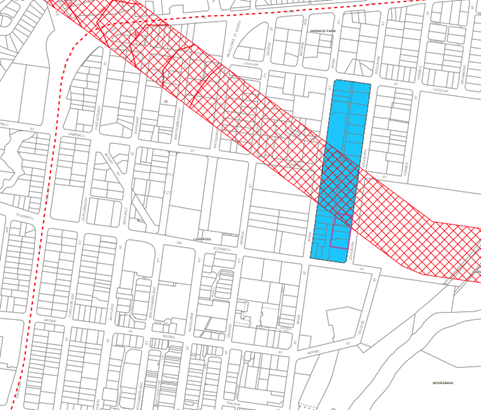
Map 2. Key Site Maps within the LIP
Development
Activity in the Liverpool CBD
Although, there is significant capacity under the
Liverpool Local Environmental Plan 2008, there has been limited take up since
the implementation of Amendment 52. Since September 2018, 15 major Development
Applications have been lodged and approved (or currently under assessment)
within the Liverpool CBD for residential purposes (Residential Flat Buildings,
Shop-top housing, Multi-dwelling and Boarding House). Noting, this does not
include the DA / Modification application relating to Civic Place. A full list
of the relevant Development Applications is included in Appendix 1.
In addition, 61-71 Goulburn Street has been subject to
a planning proposal to facilitate the development of the Liverpool Private
Hospital. This planning proposal was finalised in late 2023, and a State
Significant Development Application has been lodged to the Department of
Planning, Housing and Infrastructure.
Current
LEP Amendments:
Council
staff are currently drafting a new Principal Local Environmental Plan. As part
of this process, investigations which have resulted in recommendation to amend
some controls within the City Centre. Specifically, Clause 7.5a is proposed to
be amended, as follows:
· Reduced Commercial Gross Floor Area (GFA): Reduction of 20% GFA requirement for
commercial uses to minimum of 15% GFA, to achieve the bonus height of building
and Floor Space Ratio as per this clause. If the market demand enables greater
than 15% for non-residential uses, this can still be achieved under this
clause.
· Inclusion of Build to Rent: Introduction of Built to Rent (BTR) to
be classified as a commercial use, to achieve the bonus development standards
as per this clause.
· Clause 4.6 Variation: Removal of this clause as a prohibition
of 4.6 Exception to Development Standards, to enable flexibility where minor
variations can be accommodated, for 7.5A(1) only, i.e. only site size and
street frontage requirements, and not the bonus development standards.
· New Area for Liverpool Hospital: Introduction of a new Area 9 (Mixed Use)
provision for land directly west of the Liverpool Hospital. It is noted this
land is primarily strata units and would require 2 lots to be amalgamated for
the bonus to occur. The Liverpool Private Hospital has recently completed a
planning proposal for increased HOB and FSR (79m and 6.9:1 respectively) within
this marked area. This FSR is commensurate to the Area 9 standards. Further
consideration of Hospital Flight Paths, solar access and overshadowing will be
required.
Examples
of Health and Education Precincts throughout Sydney:
Throughout
Greater Sydney, there are other Health and Education precinct which aim to
facilitate similar outcomes to those aims for the Liverpool Innovation
Precinct. A few examples are marked on the map and outlined below.

Map 3. Examples of similar precincts
within Greater Sydney
a)
Blacktown Health and Education
Precinct
i. Location: The Blacktown Health and Education Precinct is
located between Blacktown CBD and Blacktown Hospital. The precinct is
approximately 20ha in size and bounded by the Western Railway line to the
north, Sunnyholt Road and Newton Road to the west, Griffiths Street, Marcel
Crescent and Blacktown hospital to the east, and Bungarribee Road to the south.
A map of the precinct in shown below.
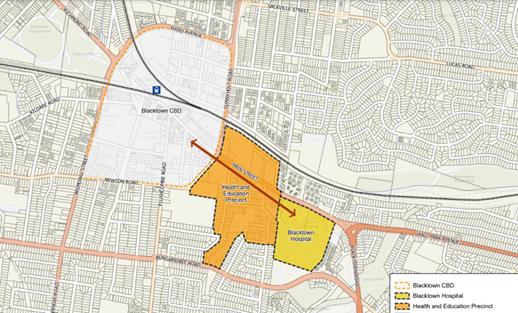
Map 4: Map of Blacktown Health and
Education Precinct
ii. Planning Controls: The area was subject to a recent planning
proposal which was gazetted in December 2022. The planning proposal rezoned the
area and amended building heights and created additional local provisions to
incentivise development. The in-force building heights and floor space ratios
for the Health Precinct and surrounding CBD are outlined below.
|
|
Blacktown
LEP 2015 (in force)
|
Comment:
|
|
Land
Use Zoning
|
B4 Mixed Use
SP1 Special Activities
(Health Service Facilities and Educational Establishment)
|
The zoning was recently
amended as part of the planning proposal which was gazetted in December 2022.
|
|
Floor
Space Ratio
|
N/A
|
Blacktown does not specify
floor space ratios in the health and education precinct.
|
|
Height
of Building
|
Varies.
Between 14-32metres.
Up to 44m (will be subject
to design excellence being demonstrated through a design competition, and
buildings having the maximum floor plate of 1,000m2
|
The Height of building was
recently amended as part of the planning proposal which was gazetted in
December 2022.
|
Table 4: Land use controls outlined in Blacktown LEP 2015
b)
Westmead Health and Education
Precinct
ii
Location: The Westmead Place Strategy
has seven sub precincts, and the Westmead Health and Innovation precinct is one
of the sub-precincts. The sub-precinct is situated to the north of Westmead
Station, containing health, research, innovation and education facilities. The
centre core is defined by Westmead Hospital, and the Childrens hospital
Westmead.
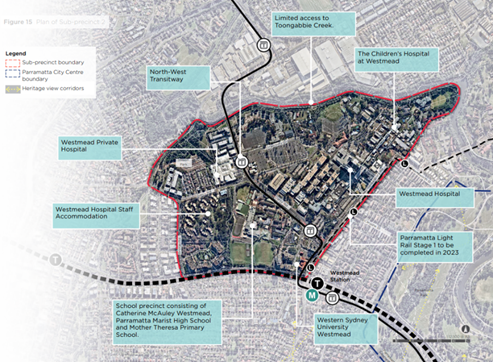
Map 5: Westmead Precinct
ii)
Planning Controls Under the
Parramatta LEP the following development standards apply to the precinct:
|
Land use
|
Floor Space Ratio
|
Maximum
Building Height
|
|
MU1 Mixed use
|
1.5
|
12m
|
|
3.0
|
31m
|
|
3.5
|
40m
|
|
4
|
48m
|
|
SP2 Special activities
|
Health Services
Facility
|
n/a
|
n/a
|
|
Educational
Establishment
|
n/a
|
n/a
|
|
R4 High Density Residential
|
1.7
|
20m
|
|
RE1 Public Recreation
|
|
|
Table 5: Land use controls outlined in Parramatta LEP 2023
c)
Campbelltown / Macarthur
i) Location:
Whilst the Campbelltown Macarthur example is not specifically identified as a
health or education precinct. It is a useful example given it has similar
anchor tenants to Liverpool. These include, a train station, shopping centre,
two hospitals, and a university on the periphery. The area shown on the below
is 100ah, which is of similar scale to the Liverpool Innovation Precinct. A
map, and the applicable development standards a shown below.

Map 6: subject area referred to:
Campbelltown
ii)
Planning Controls Under Campbelltown LEP, the following controls apply
to the area referenced in Map 6.
|
Land use
|
Floor Space Ratio
|
Maximum Building
Height
|
|
MU1
Mixed use
|
n/a
|
19m
|
|
n/a
|
22.5m
|
|
n/a
|
32m
|
|
E2
Commercial Core
|
n/a
|
32m
|
|
SP2
Health Services Facility
|
n/a
|
n/a
|
|
R4
High Density Residential
|
n/a
|
22.5
m
|
|
R3
Medium Density Residential
|
n/a
|
9m
|
|
RE1
Public Recreation
|
n/a
|
n/a
|
|
|
Table 6. Land use controls outlined in Campbelltown LEP
|
Conclusions and
Recommendations
The
projects identified within the Master Plan provide a comprehensive approach
towards uplifting the overall character of Liverpool City Centre and supporting
the growth and development of the LIP. Good Urban Design outcomes have the ability to alter the
perception of a place and attract the right people and investors. With the
Master Plan and the Technical Manual as key documents helping to guide the
future growth and development of the LIP, Council and the community are well
placed to ensure our future is prosperous.
The
land-use controls within the Liverpool Innovation Precinct are very generous,
especially when compared to other precincts of similar scale within Greater
Sydney. Whilst land use planning is an important factor in promoting
development and growth within the Liverpool Innovation Precinct, market factors
are outside control of Council. Since Covid-19, the building industry has
suffered from labour shortages, significant increases in the price of building
materials as well as rises in interest rates. These factors are considered a
bigger hinderance on the completion of Development Applications rather than
planning controls. This is especially true when considering the scale of
development already permitted under the existing planning controls.
Given the information above, Strategic Planning and
City Design and Public Domain Teams recommend the following:
· Prioritise the implementation of the Master Plan
Projects in the Liverpool Innovation Precinct to be Fast-tracked’.
· Develop a CBD Signage Strategy as part of
Council’s FY 24/25 budget;
· Implement the CBD Signage as part of Council’s
FY 25/26 budget;
· Undertake additional street tree plantings in
Elizabeth and George Streets as part of Council’s FY 24/25 Budget;
· Implement multi-function poles and banners in the
Liverpool Innovation Precinct as part of Council’s 24/25 budget; and,
· Advocate for key investment from the State Government
which will be a catalyst for private investment.
There are no direct financial implications relating to this
recommendation. However, individual recommendations have financial implications
which will be raised as a separate business case in the future.
|
Economic
|
Further develop a
commercial centre that accommodates a variety of employment opportunities.
Encourage and promote
businesses to develop in the hospital health and medical precinct (of the
City Centre).
Facilitate economic
development.
|
|
Environment
|
Protect, enhance and maintain areas of endangered ecological
communities and high-quality bushland as part of an attractive mix of land
uses.
|
Social
|
Preserve
and maintain heritage, both landscape and cultural as urban development takes
place.
Regulate
for a mix of housing types that responds to different population groups such
as young families and older people.
|
Civic Leadership
|
Foster
neighbourhood pride and a sense of responsibility.
Operate
a well-developed governance system that demonstrates accountability,
transparency and ethical conduct.
|
|
Legislative
|
Environmental Planning and Assessment Act 1979.
|
|
Risk
|
The risk is deemed to be Low.
There is no risk associated with this report.
|
1. Attachment
1: Recent DAs in Liverpool City Centre
|
1
|
|
ITEM
03
|
Mayoral
Minute: Liverpool Innovation Precinct
|
|
Attachment
1
|
Attachment
1: Recent DAs in Liverpool City Centre
|

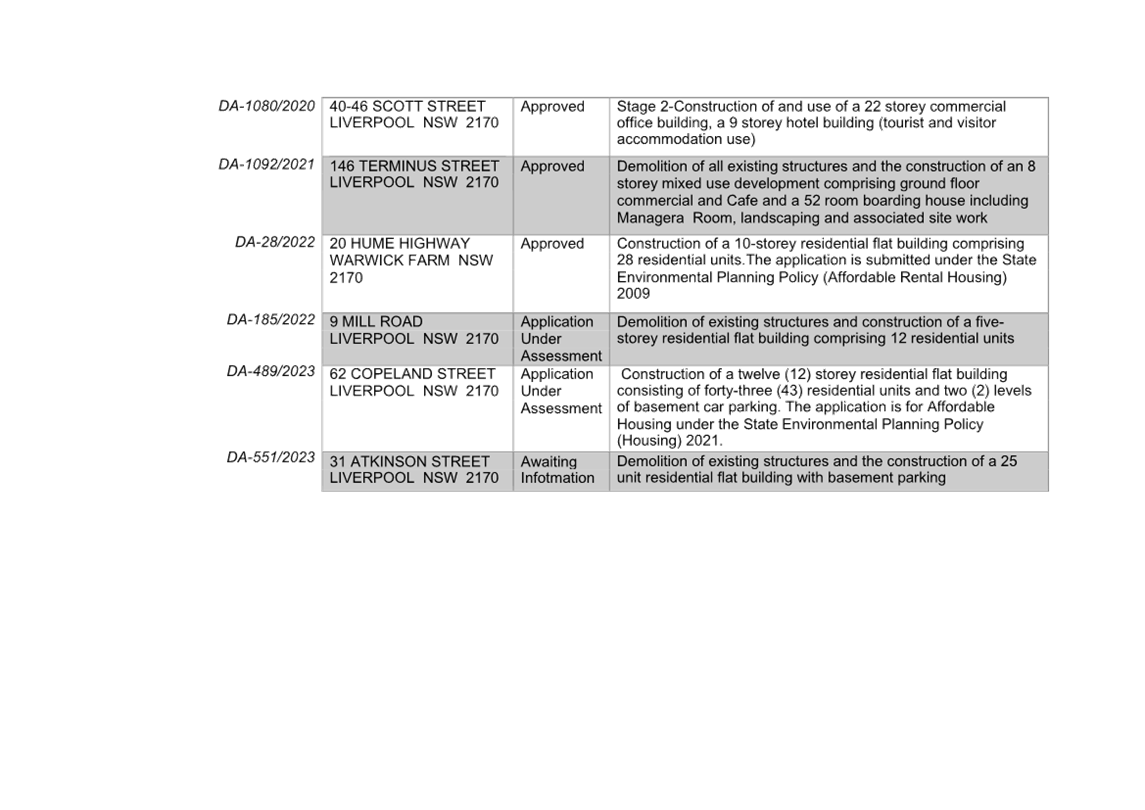
Governance
Committee Meeting
13 August 2024
Strategic Priorities Committee Report
|
ITEM 04
|
Amendments to Council Venue Hire
Policies
|
|
Strategic
Objective
|
Healthy,
Inclusive, Engaging
Improve
liveability and quality of life for the community by delivering vibrant
parks, places and facilities
|
|
File Ref
|
256544.2024
|
|
Report By
|
Craig
Lambeth - Manager Community Recreation
|
|
Approved
By
|
Tina Bono -
Director Community & Lifestyle
|
Council
avails its Community Facilities and Sporting Venues to local organisations,
clubs, schools, residents and other entities on a hire basis. These
facilities accommodate important activities that support marginalised and
targeted community groups, support small, locally based commercial entities and
attract significant locally significant external events. Collectively
Councils sporting fields and community facilities are estimated to attract
almost one million annual attendances.
The
Local Government Act 1993 defines the basis by which Council may enter leases,
licences and hire agreement on community land. Council’s Community
Facilities Generic Plan of Management is intended to ensure that Council is
compliant with its obligations under the Act. However, the Community
Facilities Generic Plan of Management was last reviewed in 2005 and
subsequently has lost pace with the development of both existing and new
community facilities.
To
improve the experience of hirers and to meet its obligations Council is
required to undertake a multi-tiered approach to improve the governance
framework of its community facilities:
Phase
1 - Update and Streamline its Policy Framework.
Phase
2 - Review of Fees and Charges; and
Phase
3 - Update its Community Facilities Generic Plan of Management.
Currently,
access to Community Halls and Sporting Fields is defined by a range of
documents that includes Policies, Terms and Conditions and Licences.
There are additional documents that define applicable charges, and
opportunities for fee reduction.
This
Report seeks to streamline these documents to allow for a more effective,
efficient and user-friendly Policy Framework. This is to be achieved
through:
· The establishment of a high-level
over-arching Policy for Hire of Community Facilities
· The establishment of a high-level
over-arching Policy for Hire of Sport and Recreation facilities; and
· The consolidation of all Terms and
Condition to form part of the Booking process.
The
current and proposed Polices are attached to this Report.
That the
Governance Committee meeting:
1. Receives and notes this Report.
2. Adopts the recommended Hire policies attached to
this Report that includes:
Community Facilities Hire Policy.
Hire of Playing Surface Policy – Sporting Fields
and Recreation Spaces.
3. Supports the inclusion of Conditions of Hire to be
contained within the Hire Agreement for Community Facilities and Sport and
Recreation spaces attached to this Report; and
4. Delegates to the CEO, the development of Conditions of
Hire for Community Facilities and Sport and Recreation Spaces.
5. Proceed to 28 days public exhibition.
Background
The provision of Council’s community venues, parks
and sporting grounds to the community is a pivotal in connecting the community
to programs, services and activities that promote physical, mental and social
wellbeing.
Council currently has approximately 35 community
facilities and 50 sporting venues available to the community with more than 120
individually bookable spaces. Attracting almost one million annual
visitations, through approximately 100 service providers, these facilities act
to that support the needs of some of Councils most marginalised groups.
In its current form, the Council relies on several
instruments to provide the governance framework for the hire and management of
venue bookings. In the case of its Community Facilities, these include:
· Commercial Businesses Short-term Hire Procedures (Terms and
Conditions)
· Community Facilities Management Casual Hire (Terms and Conditions)
· Community Venues Permanent Hire Procedures (Terms and Conditions)
· Community Facilities Licence Agreement
· Community Venues Casual Hire Procedures (Terms and Conditions)
· Change/Cancellation of Casual Facility Hiring Booking Date
· Change/Cancellation of Permanent Facility Hiring
· Community Facilities - Fee Reduction Program
Each of these documents is intended to define the Terms
and Conditions of Hire and consider varying occupancy agreements between the
Council and the Hirer.
Hire Procedures
Council has separate processes for the hire of Community
Facilities and Sporting Fields.
In the case of Community Facilities, Council enters one
of three (3) agreements:
· 3-year Licence Agreement offering exclusive access to a defined
areas within a community facility.
· A Permanent hire Agreement offering non-exclusive access to a shared
space for up to 3 years; and/or
· A Casual Hire Agreement offering one off access.
Council seeks Expressions of Interest from community
groups, organisations and individuals every three (3) years for use of its
community facilities for a 3 three (3) year period.
Expressions of Interest are considered by Council staff
based on a range of criteria that includes:
· The legal status of an organisation
· The nature of the services offered to the community
· The number of residents within the LGA that are serviced by the
organisation
· The location of the organisation’s operations
· The financial capacity of the organisation
In general terms, organisations delivering services to
targets or marginalised community groups are afforded priority of access.
For Sporting fields, Council enters one of three (3)
agreements:
· A Casual Hire Agreement for one-off bookings
· A Seasonal Hire Agreement for shared use facilities; and/or
· A Licence Agreement for up to 5 years for exclusive facility use.
Council receives application for sporting ground use
every six months for the following seasonal period.
The feedback from community groups is that the current process
is cumbersome in nature.
Permissibility
Council’s Community Facilities Generic Plan of
Management 2005 (PoM) and Generic Sportsground Plan of Management are the
guiding documents that intended to demonstrate that Council satisfy the
obligations contained in the Local Government Act 1993. The PoMs provides
a framework for the long-term management of Sporting facilities and Community
Facilities erected on land classified as ‘community’ land and
‘crown’ reserves in Liverpool City Council. The Generic Plans
of Management contains most of the Council’s Community Facilities noting
that in some cases, individual PoMs for specific sites have been developed.
The Local Government Act 1993 restricts leases or
licenses over community land. Leases or licenses for a period of five (5) years
or more have limitations imposed on them with the maximum period that leases or
licenses can be granted for is 21 years.
Importantly, PoM’s permit Council to enter a licence, lease or
other such instrument consistent with the specifications contained within the
Local Government Act 1993.
In general terms, and for the purpose of this report, the Plans of
Management, while acknowledging the need to update, meet the required statutory
obligations. A further Report specifically related to Plans of Management
will be provided to Council for consideration.
Summary of Policy Changes
The current policy framework and associated
implementation processes required to hire a community facility on a perpetual
basis is both cumbersome and complex in nature for its intended purpose.
To improve the effective implementation of the
governance framework the following changes are recommended:
1. Establishment of a Community Facility Hire Policy
There is currently no Policy that defines the intended
purpose of Council’s Community Facilities. The establishment of a
Community Facilities Hire Policy will define the strategic objectives of the
venues and allow an effective framework for implementation and assist in the
decision-making process.
The cluster of documents that form Council’s
Conditions of Hire (listed above) can be streamlined and incorporated into the
Conditions of Hire forming the agreement between Council and the Hirer.
A copy of the proposed policy is to be tabled.
2. Establishment of Sporting Grounds and Passive Parks Hire Policy
The current Hire of Playing Surface Policy acts to
define the governance and operational requirement. To ensure consistency with
the Community Facilities Hire Policy, the establishment of a Sporting Grounds
and Passive Park Hire Policy will define the strategic objectives of
Council’s Sportsgrounds and Passive Parks and assist in decision
making.
Costs
associated with this recommendation have been included in Council’s
budget for the current year and long-term financial plan.
|
Economic
|
There are no economic and financial considerations.
|
|
Environment
|
There are no environmental and sustainability
considerations.
|
Social
|
Raise awareness in the community about the available services and
facilities.
Provide cultural centres and activities for the enjoyment of the arts.
Support community organisations, groups and volunteers to deliver
coordinated services to the community.
|
Civic
Leadership
|
Deliver services that are customer focused.
|
|
Legislative
|
Local Government Act 1993
(Division 2 – Part 2 – Section 35) and (Division 12 – Part
1 – Section 356)
Local Government (General)
Regulations 2021 (Division 5 – Part 2 – Section 49)
Generic Plan of Management:
Community Facilities, 2005
Crown Land Management Act 2006
|
|
Risk
|
The risk is deemed to be Low.
|
To be tabled
Governance
Committee Meeting
13 August 2024
Strategic Priorities Committee Report
|
ITEM 04
|
Library Collection Development Policy
|
|
Strategic
Objective
|
Healthy,
Inclusive, Engaging
Support an
inclusive community by fostering access and equity for all
|
|
File Ref
|
258503.2024
|
|
Report By
|
Elysa Dennis
- Manager Library & Museum Services
|
|
Approved
By
|
Tina Bono -
Director Community & Lifestyle
|
The
purpose of the Library Collection Development Policy is to provide a framework
for the management of library collections available to the community through
Liverpool City Libraries.
The
library develops, maintains and provides access to collections of resources
to meet the information needs and
interests of the community. This is to ensure free and equitable access to
information for everyone and is reflective of the diversity of the community
and wide viewpoints.
The Library Collection
Development policy provides the principals for purchase, access and disposal of
resources, ensuring that the library meets its legal obligations under the
Library Act 1939. This policy guides staff decisions and informs community
enquiries regarding the collection.
The current policy was last
amended in 2012, and it reflects processes and an operational environment that
is no longer relevant. The proposed policy has been reviewed and
rewritten to reflect current policy formats, processes and legislation. The revised
policy focuses on core principals and outcomes, rather than prescriptive
processes.
That the
Governance Committee meeting:
1. Recommends the proposed Library Collection Development Policy be
adopted by Council; and
2. Proceed to 28 days public exhibition.
Background
Council’s Library Services provide education,
social and recreational services to the community. This supports lifelong
learning and is intended to improve the quality of life through resources and
services that reflect a wide range of tastes, opinions and viewpoints.
The community places a high value on the collections
provided. With access to those collections being prioritised and
reflected by the community in community surveys and consultation.
Councils in NSW operate their libraries under the
Library Act 1939 in partnership with the state government through the State
Library NSW.
Liverpool Council has agreed to operate its libraries in
accordance with the Act and the Guidelines issued by the Library Council of NSW
under the Act. In accordance with the requirements of the NSW Government Public
Library Subsidy.
Section 10 of the Act sets out that access to libraries,
collections, reference and information
services must be offered free of charge, and that anyone
may enter a library and access
collections and information services.
Collections in Liverpool are managed in accordance with
the Access to Information in NSW Public Libraries Guideline, issued by the
Library Council of NSW under s10 (5) of the Act.
Collection Management
The Council’s library collections are a
significant asset and are carefully managed by qualified professionals to
ensure they meet community objectives and legislative requirements.
They are developed regarding the different demands
across the LGA. The collection is available in physical and digital
formats, in multiple languages and to reflect the wide diversity of the
community interests and needs.
The Library Collection Development policy provides
guidance to library staff and informs the community about the collection. It
also ensures that the collection is an unbiased source of information,
supporting the principles of access and equity to all members of the community
essential to an informed and engaged community.
The current Library Collection Development policy was
last amended in 2012. If reflects a different environment for the
provision of library services, although it follows the same principles.
Proposed Library Collection Development Policy
The proposed Library Collection Development Policy is a
new policy, rather than an amendment of the current policy. The current
policy is attached for review.
The proposed policy is reflective of the legislative
requirements for provision of public libraries under the Library Act 1939
(NSW). Focused on the principals of access and equity and the library as
a source of unbiased information.
Details of processes for collection management have been
removed, being more suited to internal procedures and standards.
The policy will be used by library staff to define the
scope of collections, assisting with contract management with suppliers. It
will help ensure that the collection is representative of the whole community.
The policy also informs the community on collections
decisions, helping to explain why resources are included in a collection.
It will also help to communicate the role the Australian Classification Board
guidelines on access to resources in the Australian environment.
The proposed policy is representative of current
standards and guidelines for NSW Public Libraries.
Costs
associated with this recommendation have been included in Council’s
budget for the current year and long-term financial plan.
|
Economic
|
There are no economic and financial considerations.
|
|
Environment
|
There are no environmental and sustainability
considerations.
|
Social
|
Raise awareness in the community about the available services and
facilities.
Provide cultural centres and activities for the enjoyment of the arts.
Promote community harmony and address discrimination.
Support access and services for people with a disability.
Deliver high quality services for children and their families.
|
Civic
Leadership
|
Provide information about Council’s services, roles and decision-making
processes.
Deliver services that are customer focused.
|
|
Legislative
|
Library Act 1939 (NSW)
Library Regulations 2018 (NSW)
Classification (Publications, Films and Computer
Games) 1995 (Cth)
Classification (Publications, Films and Computer
Games) Enforcement Act 1995 (NSW)
|
|
Risk
|
The risk is deemed to be Low
|
1. Collection
Development and Information Access Policy 2012
2. Draft
Library Collection Development Policy 2024
|
1
|
|
ITEM
04
|
Library
Collection Development Policy
|
|
Attachment
1
|
Collection
Development and Information Access Policy 2012
|
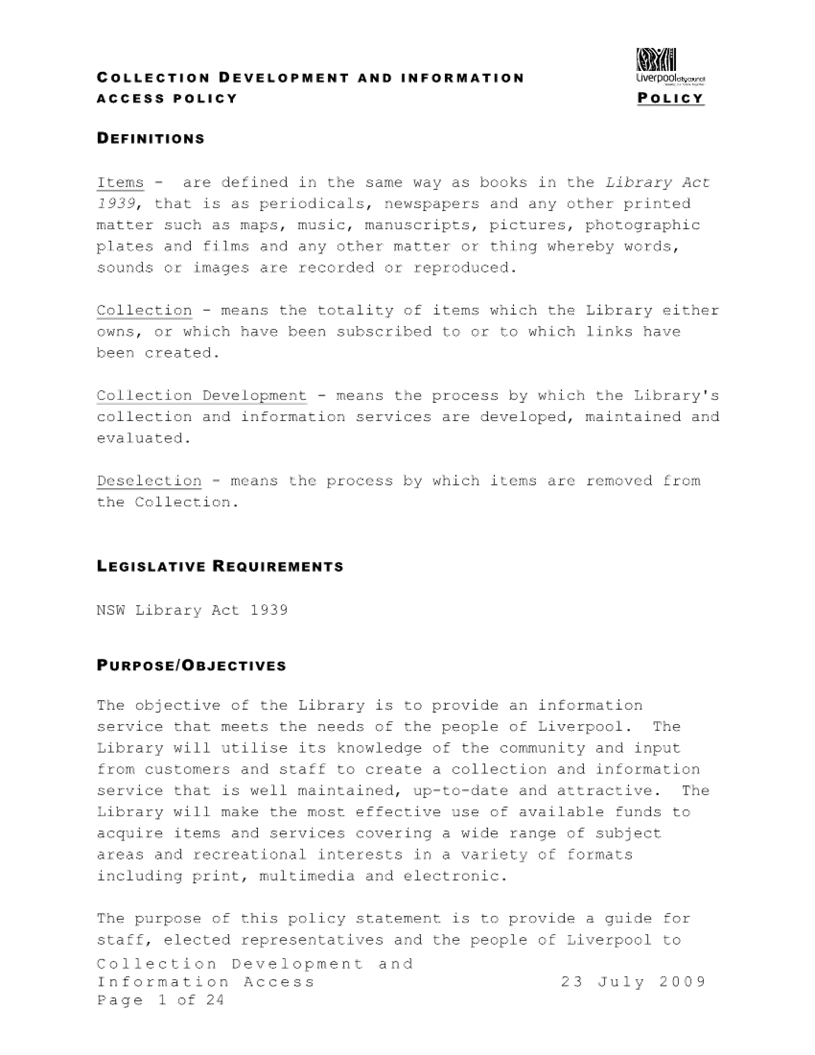

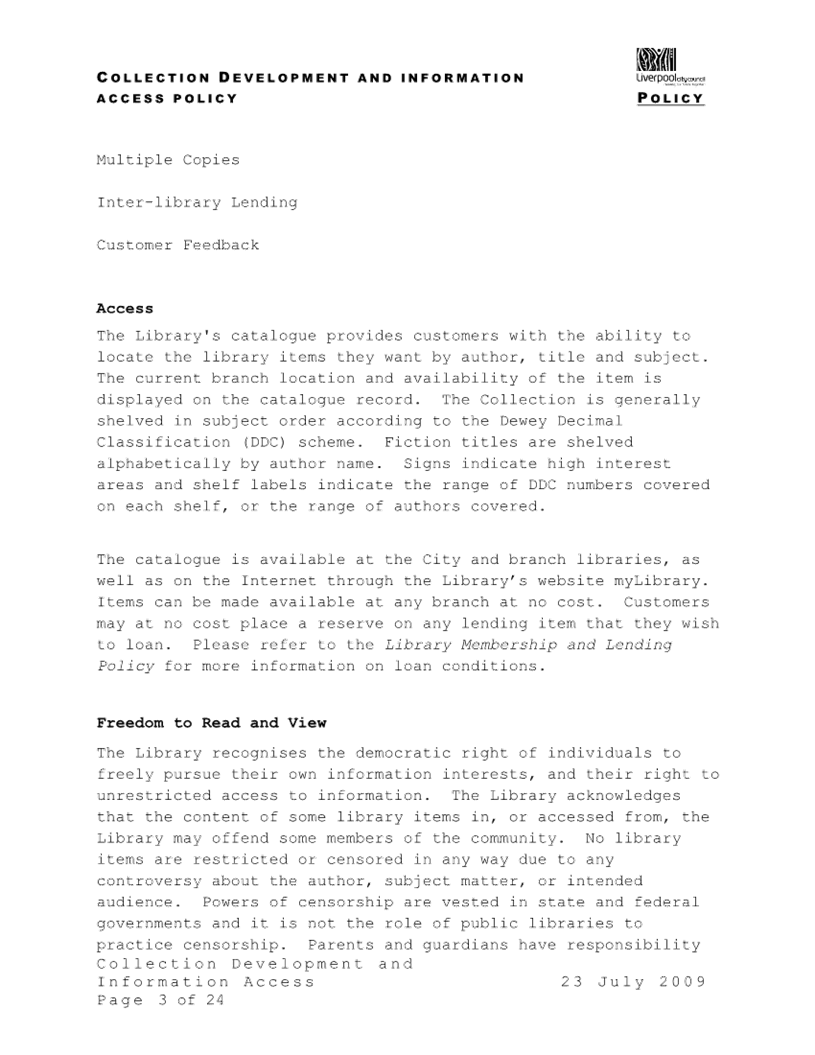
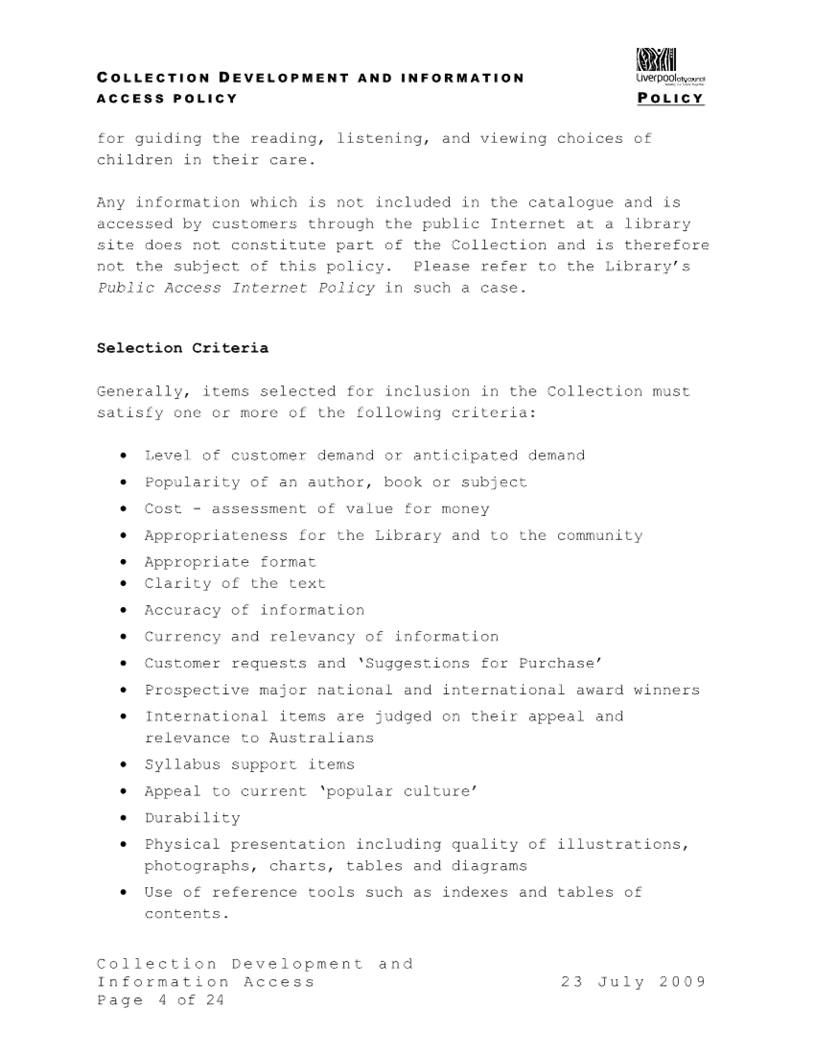
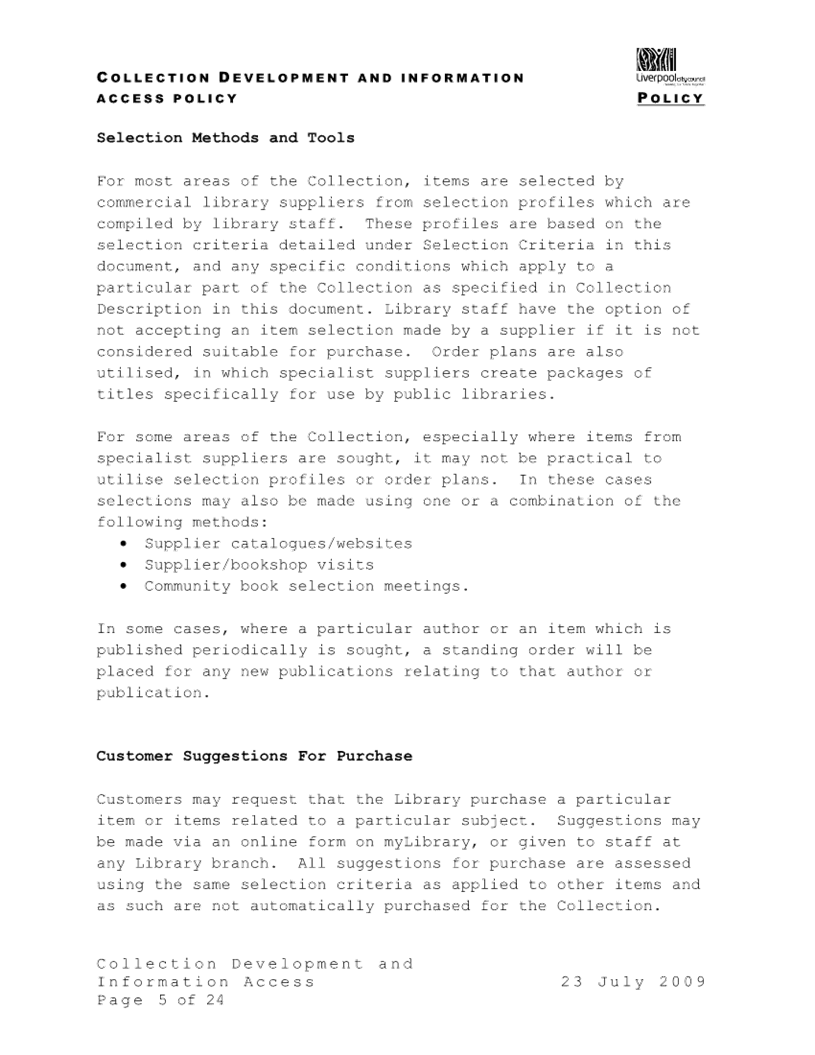
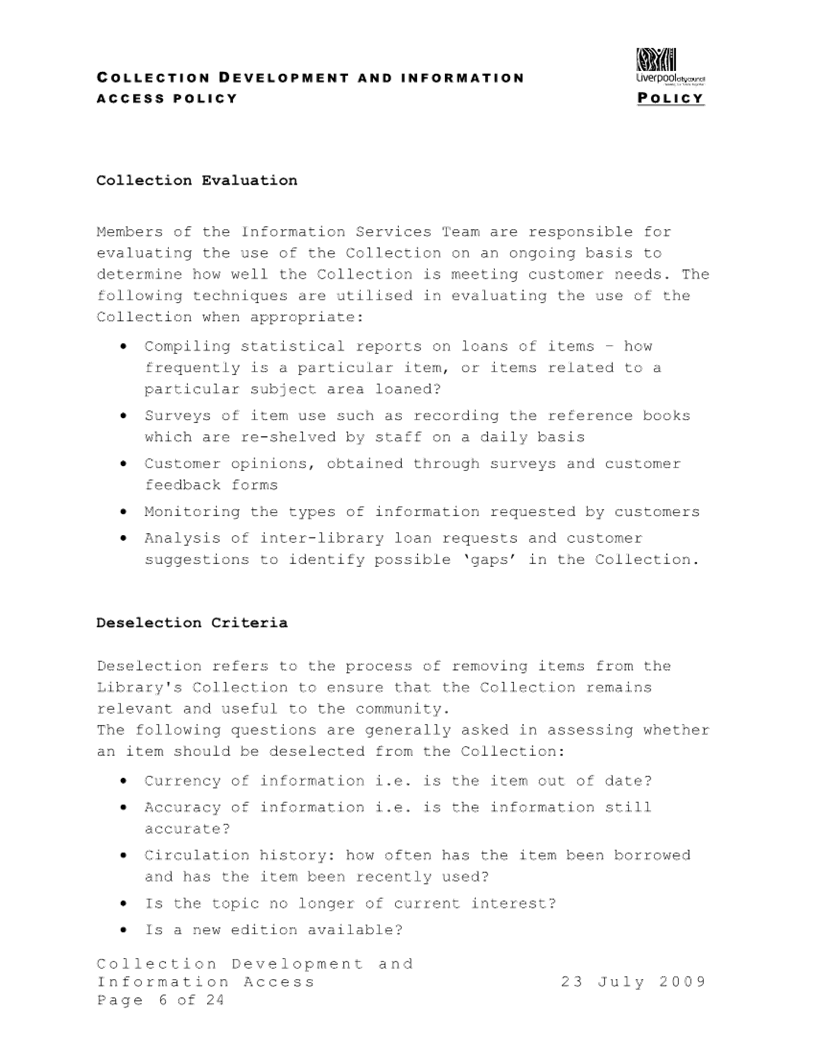
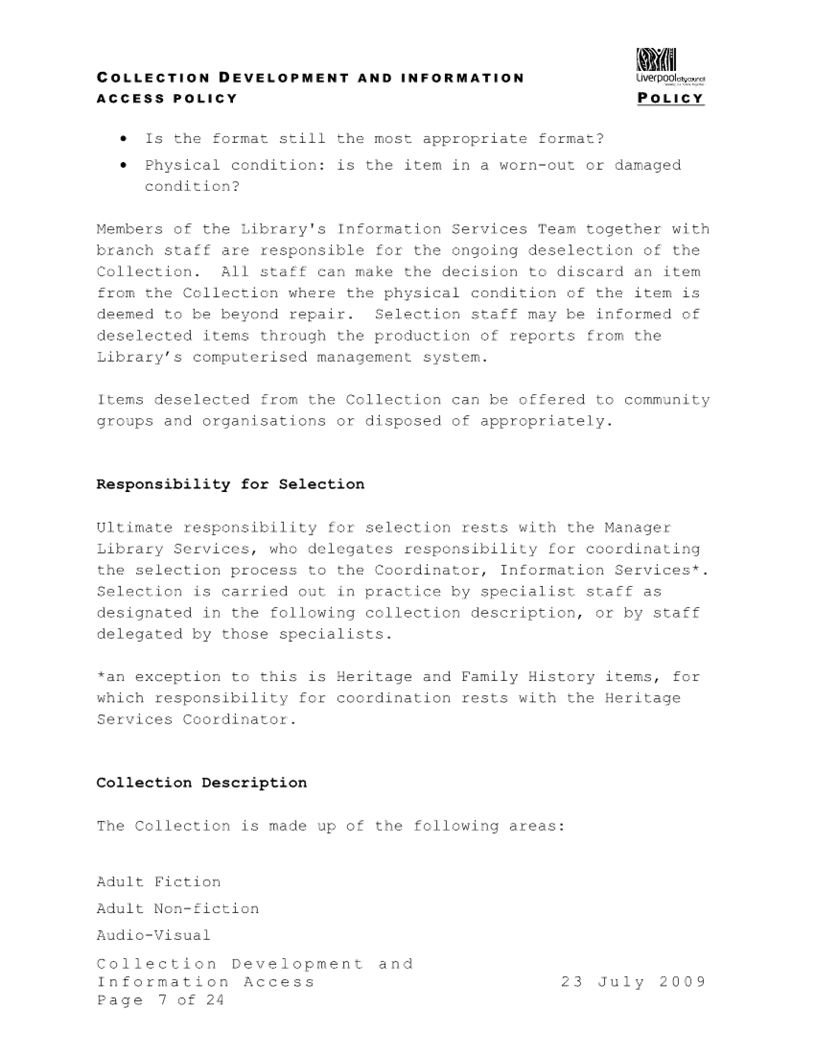
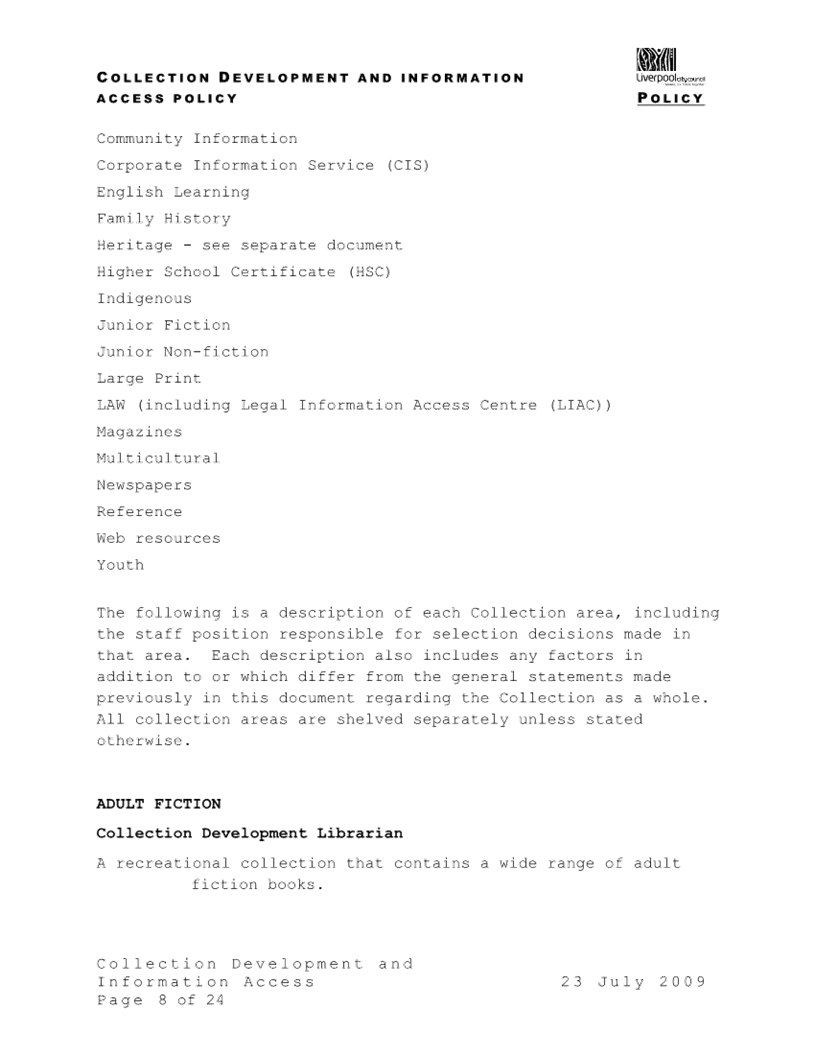
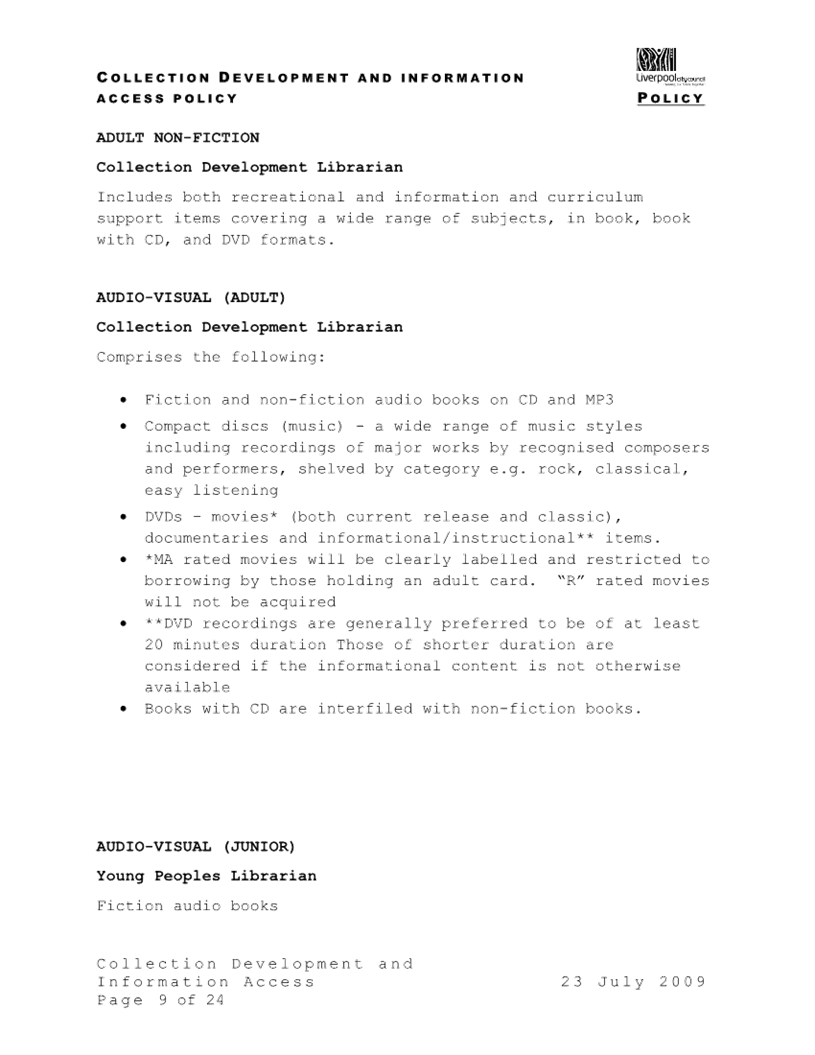
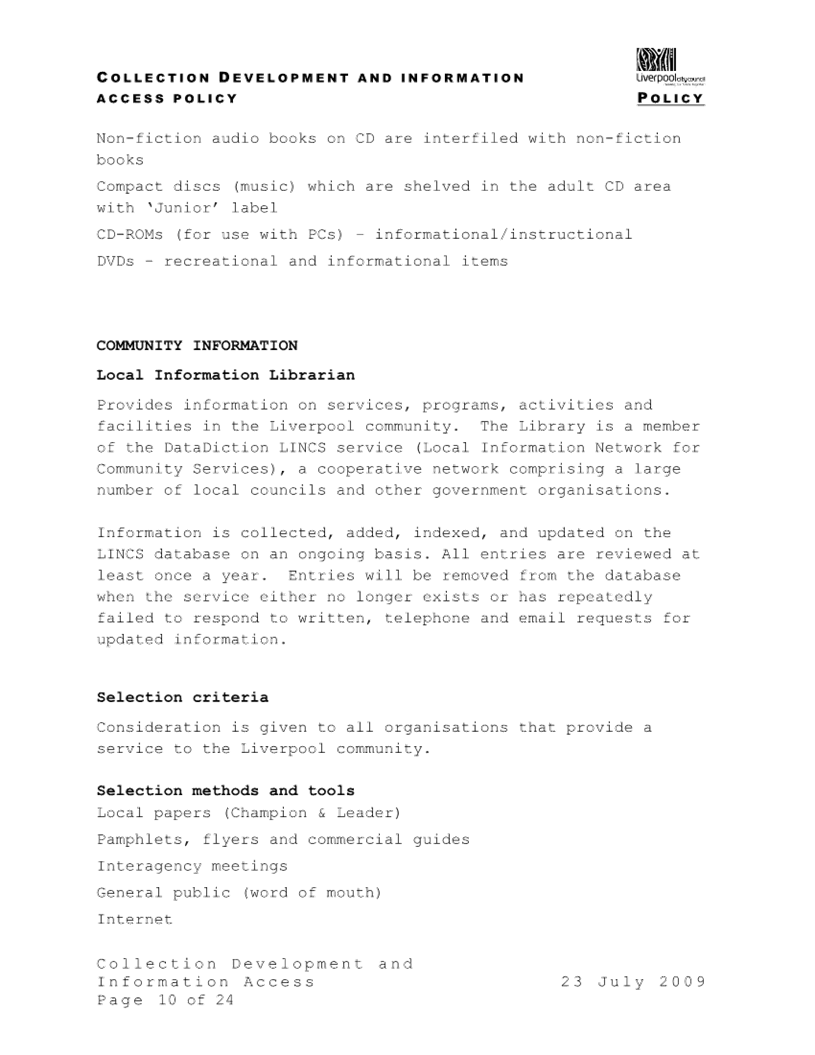
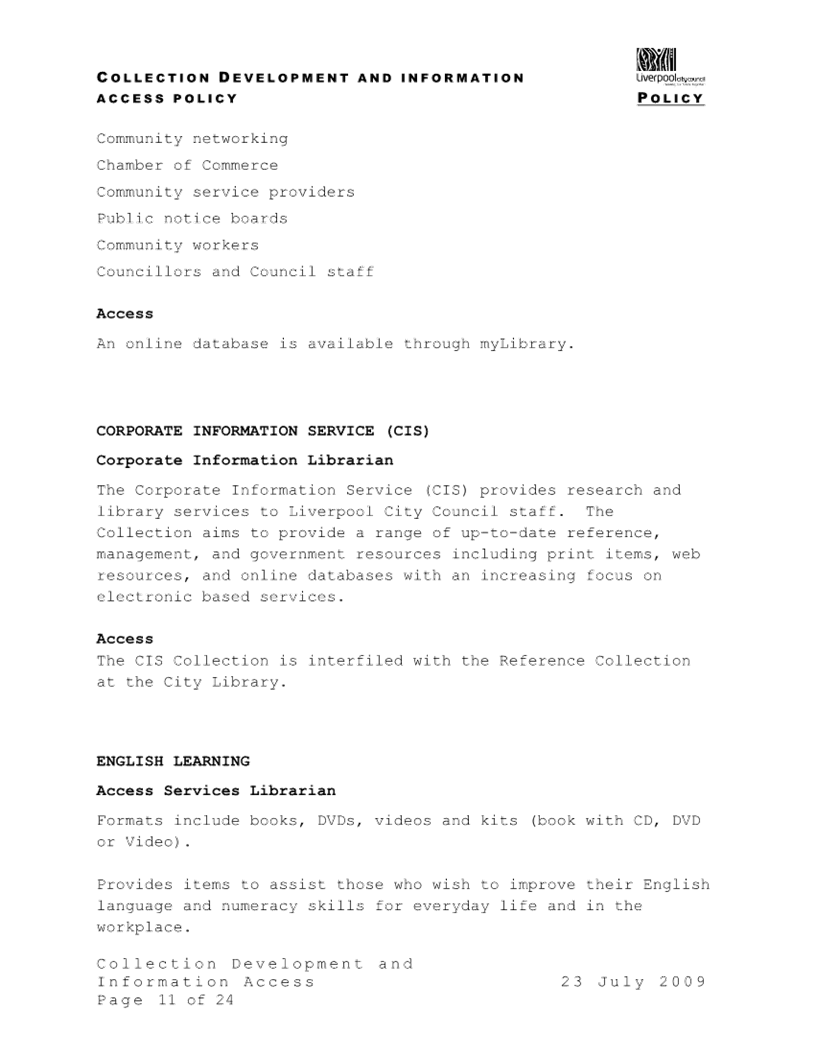
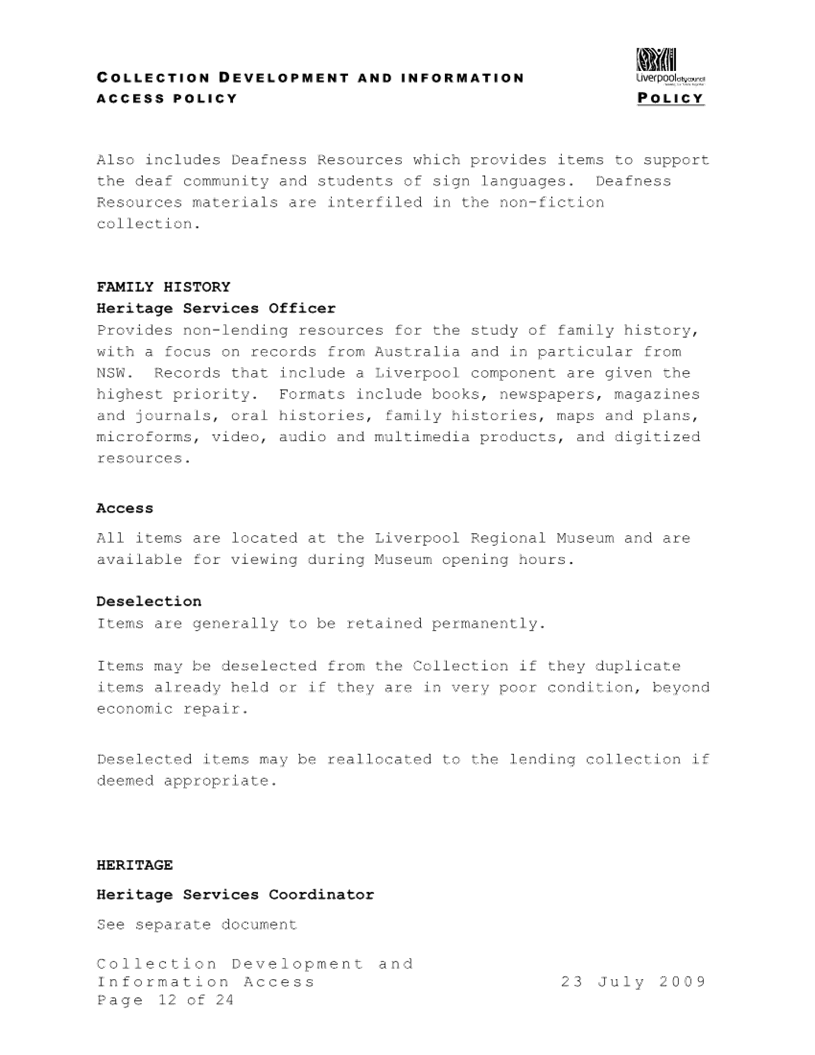
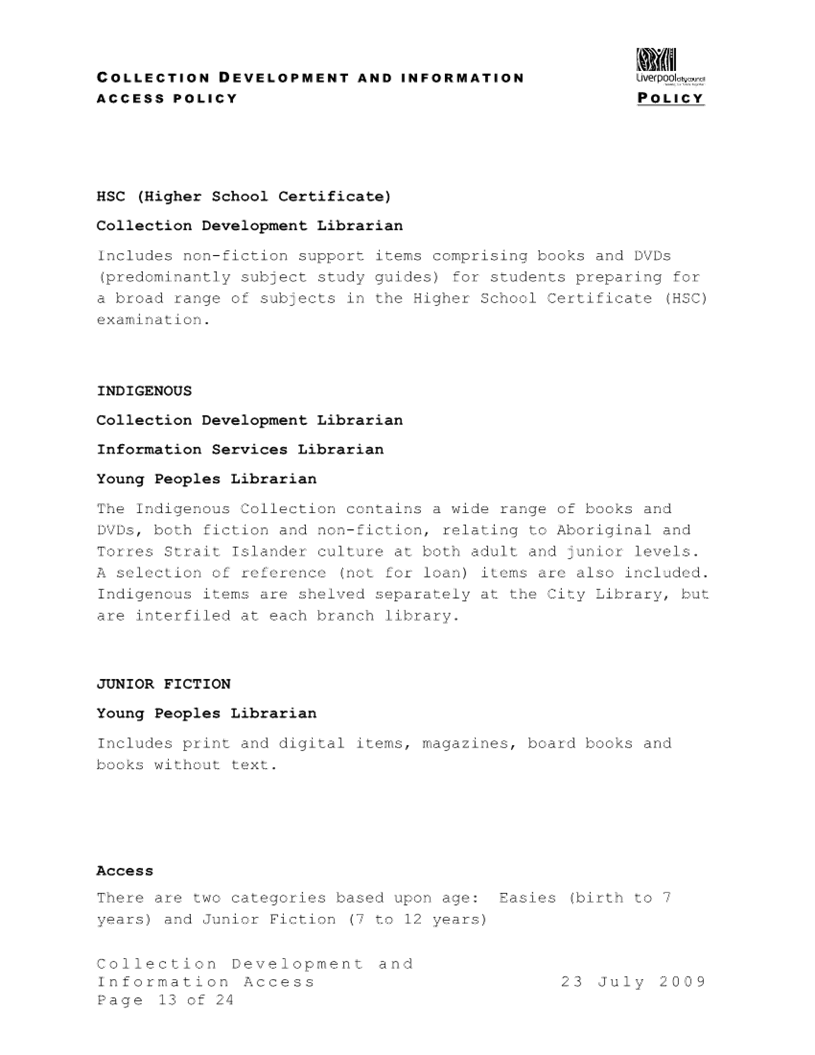
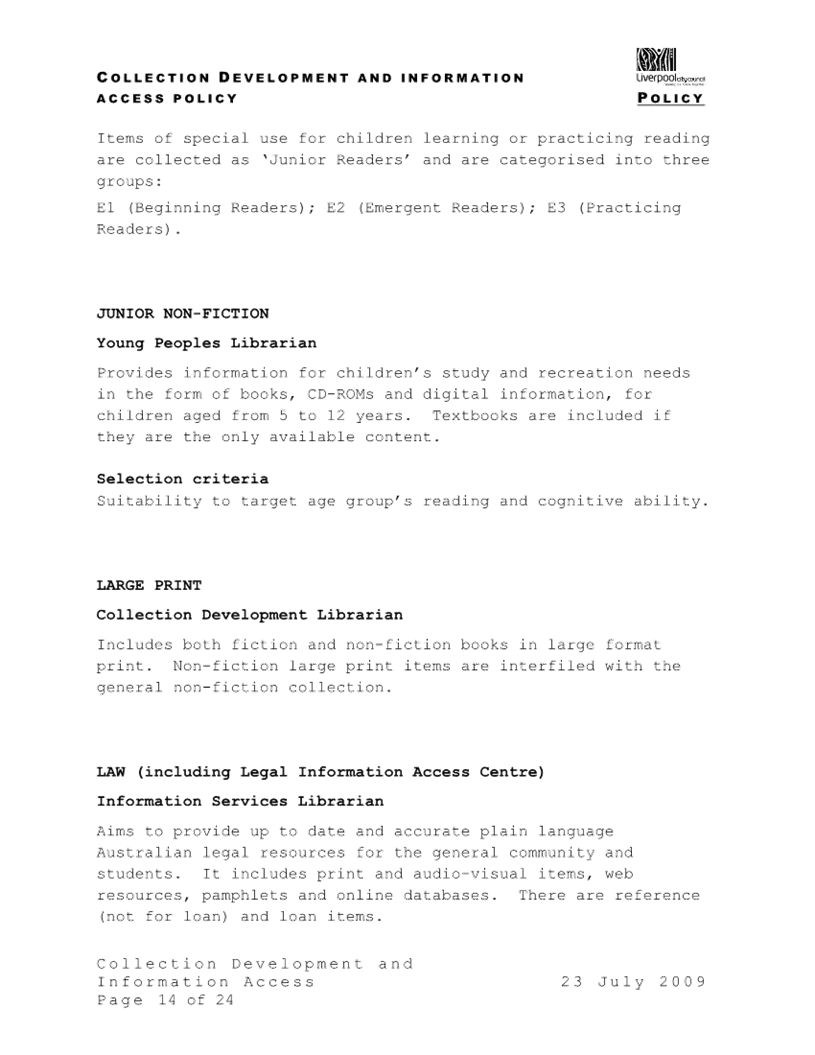
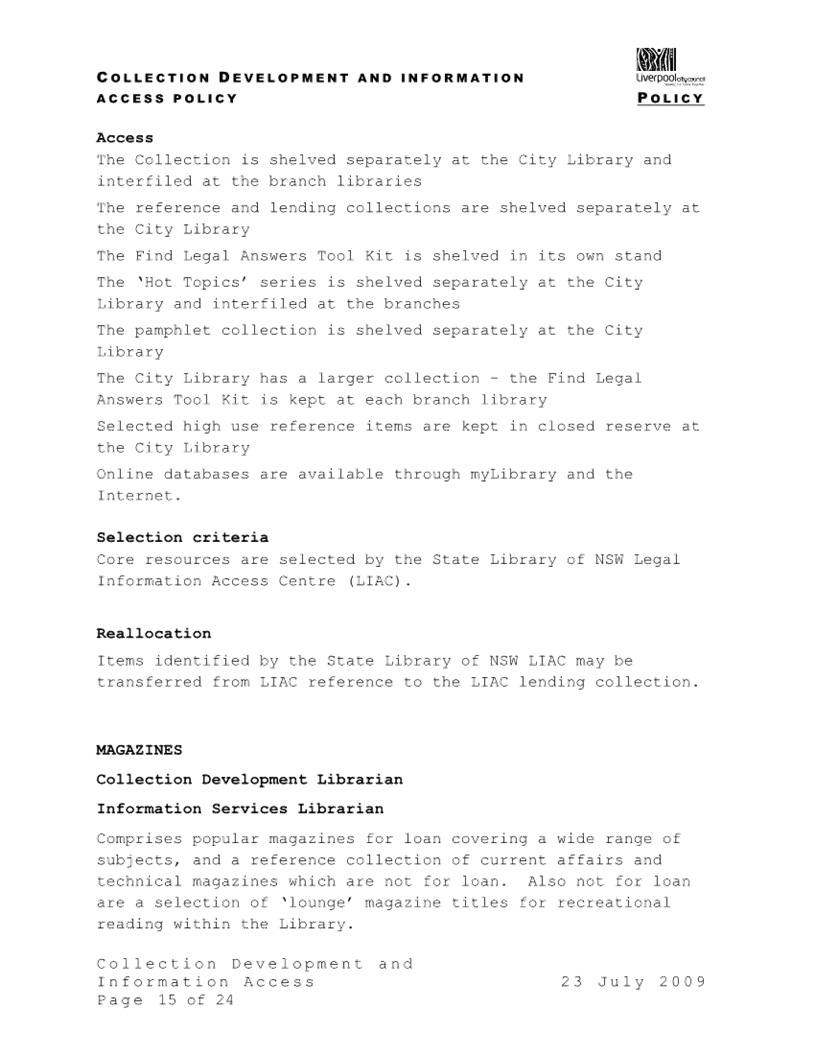



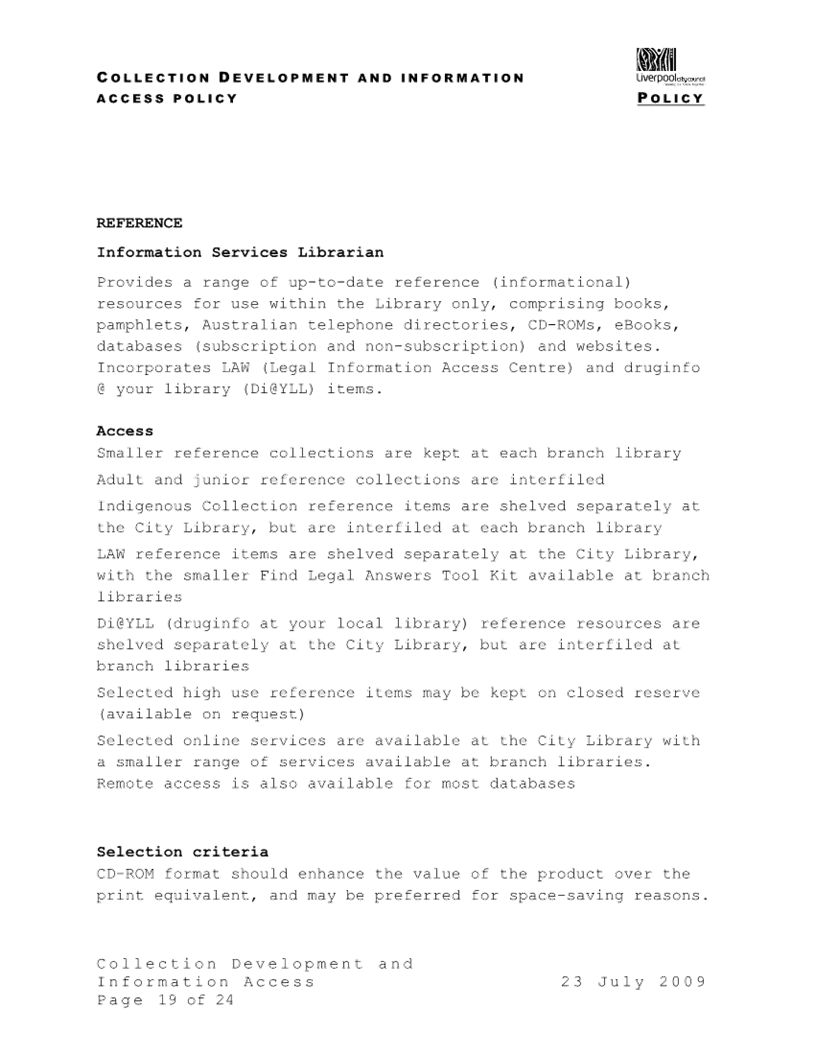
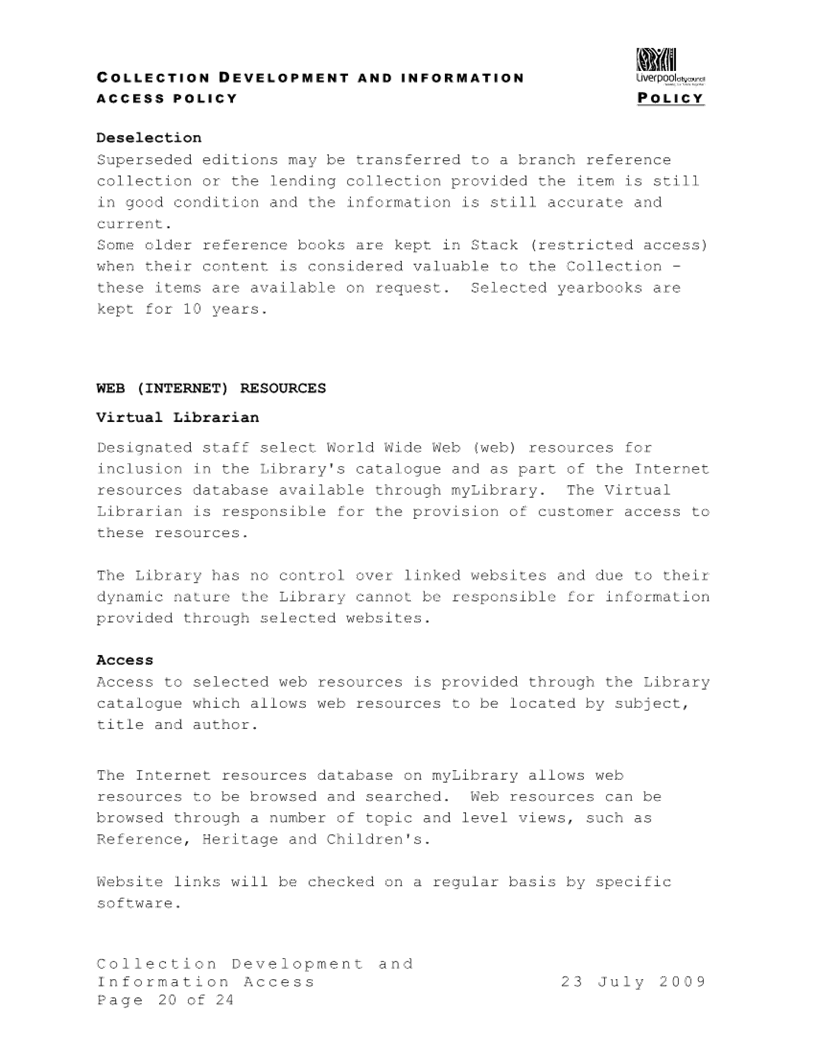
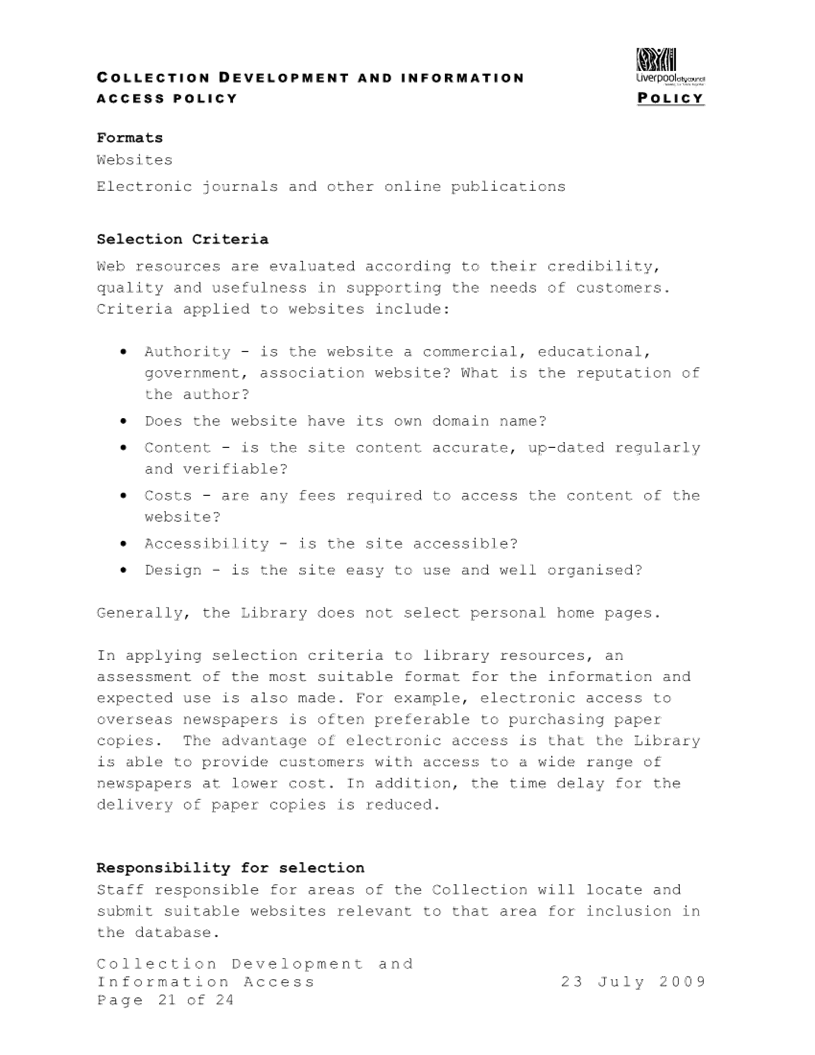



|
1
|
|
ITEM
04
|
Library
Collection Development Policy
|
|
Attachment
2
|
Draft
Library Collection Development Policy 2024
|
